- Skip to main menu
- Skip to user menu
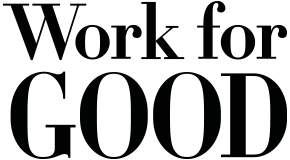

How to write a stand-out cover letter
- Career insight
(Image: FotografiaBasica )
When applying for a job, standing out from the crowd is necessary, but not easy.
One important way to differentiate yourself is with your cover letter or cover email. A strong cover letter can actually make things easier for a recruiter to view your credentials against the specific requirements for the job.
Use the “T-format” (also referred to as the “Q letter”), and you’ll literally take the reader's eyes straight from each of their requirements to your relevant experience – making it easy for them to assess and say “yes.”
The 3-part T-format cover letter
Most recruiters like this type of cover letter because it is so to the point.
This should consist of a one-page letter with plenty of white space – white space makes the content stand out – focusing on what you think is most important to the employer.
The three parts are:
1. Short opening paragraph: Begin your cover letter with a strong opening paragraph that specifies the job you are applying for and provides a good reason to continue reading. For example:
Your very interesting Senior Development Manager opportunity caught my eye this morning. As a senior fundraising officer with 10 years of experience in the discipline, my experience matches your requirements. For three years I have been leading the Organization XYZ fundraising team, with over $2.5 million in revenue generated for each of the last 2 years, well above our goals.
2. Requirements/qualifications matches: Review the job description and make a list of the key requirements. This shouldn't be an exhaustive list: Identify the top three or four things the job requires. Against each one of those requirements, identify specific experience you possess that’s relevant to the requirement.
Present them on the page in a way that is clear and stands out. Remember to be brief but accurate: It may be necessary to reduce the company's requirements and your experience to a few words in order to fit this layout, as in the example below:
3. Positive closing paragraph: Continue to express your interest, enthusiasm, and fit. Add a strong, positive closing paragraph or two emphasizing what you know about yourself and your ability to contribute. For example:
I know that this opportunity will leverage my experience in fundraising, my MBA from [ABC University], and my passion for helping excellent causes secure the resources they need. I look forward to hearing from you and discussing this opportunity in detail.
Add an appropriate business closing and your signature, with your LinkedIn profile URL and personal phone number.
The Bottom Line
In any job application, your objective is to capture the recruiters' attention and make it easy to say “yes.” What could make it easier than a short list of their needs and how your specific experience matches each one?
These letters get attention largely because they don't require much eye time. With lots of white space, they are very much like reading newspaper headlines; the eyes quickly grasp what is being presented, leading to fast assessments. Presumably, that attention moves your resume to the "Contact" pile while others are moved to the "No thanks" pile.
Sandra A. MacKay is an independent recruiter and outplacement counselor in Massachusetts, and a contributor at Job-Hunt.org .
This article was fact-checked and updated in February 2024, and originally appeared in a slightly different form on Job-Hunt.org.
Feeling informed, inspired, and empowered? Now's the perfect time to search for your next job ! Or set up a job alert , and bring the search to you.
Share this article
Related articles

Jobseeker resources: Guides, services, and pros we trust

Jobs of the week

What on-the-job professional development means (and how to ask for it)
Latest articles, employer resources: guides, tools, and sources we trust.

How to Write a Cover Letter: A Comprehensive Guide with Examples (2024)
Crafting a compelling cover letter is the first step towards landing an interview. It’s usually the first impression an employer gets before even seeing your resume, and it will help to set the tone and establish your personality before getting into your qualifications and suitability for the position.
Whether you're applying for a job, internship, or generally submitting your resume for consideration, understanding how to write a cover letter can significantly enhance your chances of success.
What is a Cover Letter?
A cover letter is a formal document accompanying your resume that introduces yourself to potential employers, highlighting your qualifications, experiences, and interest in a specific job or internship. It offers you the opportunity to showcase your personality and passion for the role in a more personalized manner than a resume alone.
Cover Letter Format
The format of a cover letter typically follows a standard business letter structure. It includes your contact information, the date, the recipient's contact details, a salutation, body paragraphs, and a closing. Ensure that your cover letter is concise, well-organized, and visually appealing, using a professional font and maintaining consistent formatting throughout.
As your cover letter will often be sent as an email, check this guide on how to write an email for some general tips on subject lines, email greetings, structuring the main content, and signing off.
Cover Letter for a Job
When applying for a job, a cover letter for your resume is often expected, and it serves as your initial introduction to potential employers. It should be customized for each position, showcasing how your skills and experiences fit the job requirements. A well-crafted cover letter can distinguish you from other applicants and increase your chances of securing an interview, especially if you can show that you’re genuinely aligned with the company’s goals.
Cover Letter for an Internship
For internship applications, a cover letter is equally essential. It allows you to convey your enthusiasm for the opportunity, relevant skills, and willingness to learn. Even if you have limited professional experience, your cover letter can highlight academic achievements, extracurricular activities, and relevant coursework that demonstrate your potential value to the organization.
Writing a Cover Letter
Let’s get into how to write a cover letter, step by step:
Step 1: How to Address a Cover Letter
When addressing your cover letter, it's essential to find out the name and title of the hiring manager or recruiter whenever possible. Addressing the letter to a specific individual adds a personal touch and demonstrates your initiative. A quick note on how to address a cover letter without a name. If you're unable to identify the recipient, you can use a general greeting such as "Dear Hiring Manager" or "Dear [Company Name] Recruiting Team."
Step 2: What to Include in a Cover Letter
Writing a compelling cover letter requires careful attention to detail and a strategic approach. Begin by thoroughly researching the company and the position to tailor your letter accordingly. Highlight your most relevant experiences and accomplishments, using specific examples to demonstrate your qualifications. Keep your language professional, yet engaging, and avoid using generic templates or clichés. Instead, strive to make a memorable impression that sets you apart from other candidates by showing you understand what the company is about.
Structure-wise, a well-written cover letter should include the following elements:
Introduction : Start by stating the position you're applying for and how you learned about it. Express your enthusiasm for the opportunity and briefly introduce yourself.
Body Paragraphs : Use one or two paragraphs to highlight your relevant experiences, skills, and achievements. Provide specific examples that demonstrate your qualifications and fit for the role. Tailor your content to align with the job description and company's needs.
Closing Paragraph : Summarize your interest in the position and reiterate your enthusiasm for the opportunity. Thank the employer for considering your application and express your willingness to discuss further in an interview.
Closing : End your cover letter with a professional closing, such as "Sincerely" or "Best regards," followed by your name and contact information.
By using this kind of cover letter template, you can keep a clear and structured approach whilst also easily adjusting your content each time to customize it for each specific contact.
Before you send
Remember maintain professionalism throughout and always proofread your cover letter before you send it off. Check this quick list of cover letter dos and don’ts so you can ensure you’ve done everything you can and haven’t made any glaring errors along the way.
Note for students: While it may be reasonable to apply for internships with your university email, it probably won’t come across as particularly professional for proper job applications. Contacting an employer from a free email account with a funny name you made when you were an adolescent also won’t be particularly impressive. You may want to use a service like Inbox.com and create a business email account that shows you’re a serious professional.
Cover letter examples
Here are some short cover letter samples that you can use as templates for your own letter. Note that although the content should be adapted both to you and to the company you’re applying to, a similar structure applies in all cases.
1. Marketing Manager Cover Letter:
Dear [Hiring Manager's Name],
I am writing to express my interest in the Marketing Manager position at [Company Name], as advertised on [where you found the job posting]. With over five years of experience in marketing strategy development, campaign management, and brand positioning, I am excited about the opportunity to contribute to your team and drive results for [Company Name].
In my previous role at [Previous Company], I led cross-functional teams to develop and execute innovative marketing campaigns that resulted in a 30% increase in brand awareness and a 25% boost in lead generation. My ability to analyze market trends, identify customer insights, and leverage data-driven strategies has consistently delivered impactful results and exceeded organizational objectives.
I am particularly drawn to [specific aspect of the company or job description], and I am eager to bring my expertise in digital marketing, social media management, and content development to support [Company Name]'s mission of [mention company mission or values].
Thank you for considering my application. I am enthusiastic about the possibility of joining [Company Name] and contributing to its continued success. I am available for an interview at your earliest convenience and can be reached at [Your Phone Number] or [Your Email Address].
Sincerely, [Your Name]
2. Software Engineer Cover Letter:
I am writing to apply for the Software Engineer position at [Company Name], as advertised on [where you found the job posting]. With a Bachelor's degree in Computer Science and three years of hands-on experience in software development and coding, I am excited about the opportunity to contribute to your team and develop innovative solutions for [Company Name].
In my previous role at [Previous Company], I played a key role in designing and implementing scalable software solutions that optimized workflow efficiency and enhanced user experience. My proficiency in programming languages such as Java, Python, and JavaScript, coupled with my strong problem-solving skills, has enabled me to deliver high-quality software solutions that meet and exceed client expectations.
I am impressed by [specific aspect of the company or job description], and I am eager to leverage my technical skills and passion for innovation to support [Company Name]'s goals of [mention company goals or objectives].
Thank you for considering my application. I am eager to further discuss how my background and expertise align with the needs of [Company Name] and am available for an interview at your earliest convenience. Please feel free to contact me at [Your Phone Number] or [Your Email Address] to schedule a discussion.
3. Graphic Designer Cover Letter:
I am thrilled to apply for the Graphic Designer position at [Company Name], as advertised on [where you found the job posting]. With a strong background in visual communication, brand identity development, and multimedia design, I am excited about the opportunity to bring my creativity and expertise to your team and contribute to [Company Name]'s success.
In my previous role at [Previous Company], I collaborated with cross-functional teams to create visually compelling designs that effectively communicated brand messages and engaged target audiences. My proficiency in Adobe Creative Suite, coupled with my attention to detail and passion for design, has allowed me to deliver innovative solutions that align with client objectives and exceed expectations.
I am particularly drawn to [specific aspect of the company or job description], and I am eager to leverage my design skills and artistic vision to support [Company Name]'s mission of [mention company mission or values].
Thank you for considering my application. I am enthusiastic about the possibility of joining [Company Name] and contributing to its creative endeavors. I am available for an interview at your earliest convenience and can be reached at [Your Phone Number] or [Your Email Address].
What is a cover letter for a job?
A cover letter for a job is a formal document submitted alongside a resume during the application process. It introduces the applicant to the potential employer and highlights their qualifications, experiences, and interest in the specific job position.
What is a cover letter for a resume?
A cover letter for a resume is a document that accompanies a resume when applying for a job. While the resume provides a summary of the applicant's skills and experiences, the cover letter offers additional context and insight into their suitability for the position.
What is the purpose of a cover letter?
The purpose of a cover letter is to introduce the applicant to the potential employer, showcase their qualifications and experiences, and express their interest in the job position. It allows applicants to personalize their application and demonstrate their enthusiasm and suitability for the role.
What does a cover letter look like?
A cover letter typically follows a formal business letter format, including the sender's and recipient's contact information, a salutation, body paragraphs, and a closing. It should be well-organized, concise, and visually appealing, with a professional tone and consistent formatting.
How long should a cover letter be?
A cover letter should be concise and to the point, typically no longer than one page. It should provide enough information to highlight the applicant's qualifications and interest in the position without overwhelming the reader with unnecessary details.
What should be in a cover letter?
A cover letter should include the sender's and recipient's contact information, a formal salutation, an introduction stating the position being applied for and how the applicant learned about it, body paragraphs highlighting relevant qualifications and experiences, and a closing expressing gratitude and interest in further discussion.
How to Start a Cover Letter
To start your cover letter effectively, consider using a strong opening sentence or attention-grabbing statement that immediately captures the reader's interest. You can mention a mutual connection, reference a recent company accomplishment, or highlight a specific aspect of the job that excites you.
How to End a Cover Letter
Ending your cover letter on a high note is crucial to leave a lasting impression. In the closing paragraph, reiterate your interest in the position and express your gratitude for the opportunity to apply. Convey confidence in your ability to contribute to the company's success. Finally, use a professional closing, such as "Sincerely" or "Best regards," followed by your name.
Updated: April 10, 2024 at 4:33 PM
Published: April 10, 2024 at 4:33 PM
You might also like
Mastering the out of office message.
What is an out of office message and how to write one? Plus examples and out of office email templates.
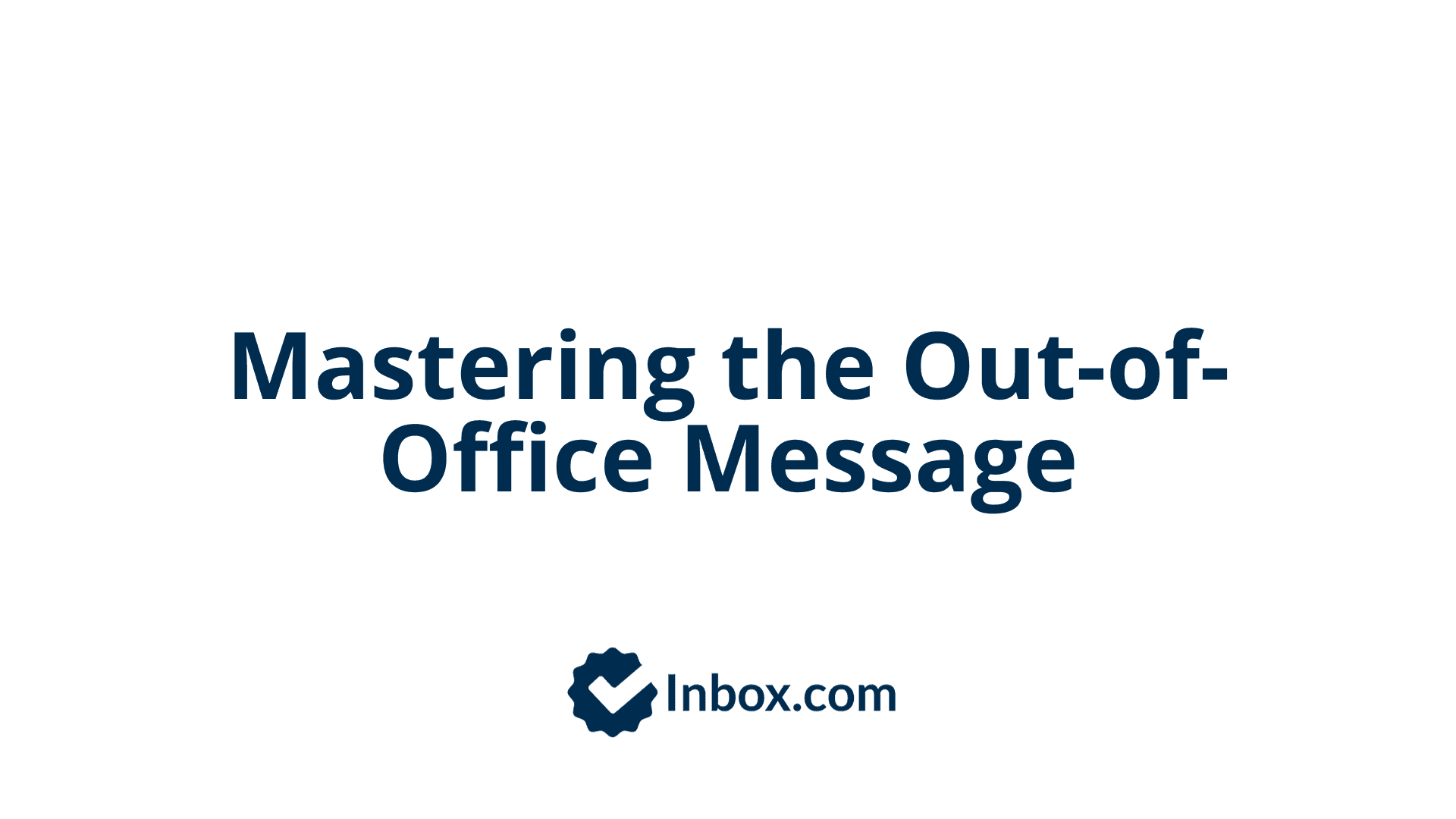
Jan 5, 2024, 6:07 PM
How To Change Your Email Password
A step-by-step guide on changing your email password on Gmail, Yahoo, Outlook, Thunderbird, iCloud, and Android and iOS devices.
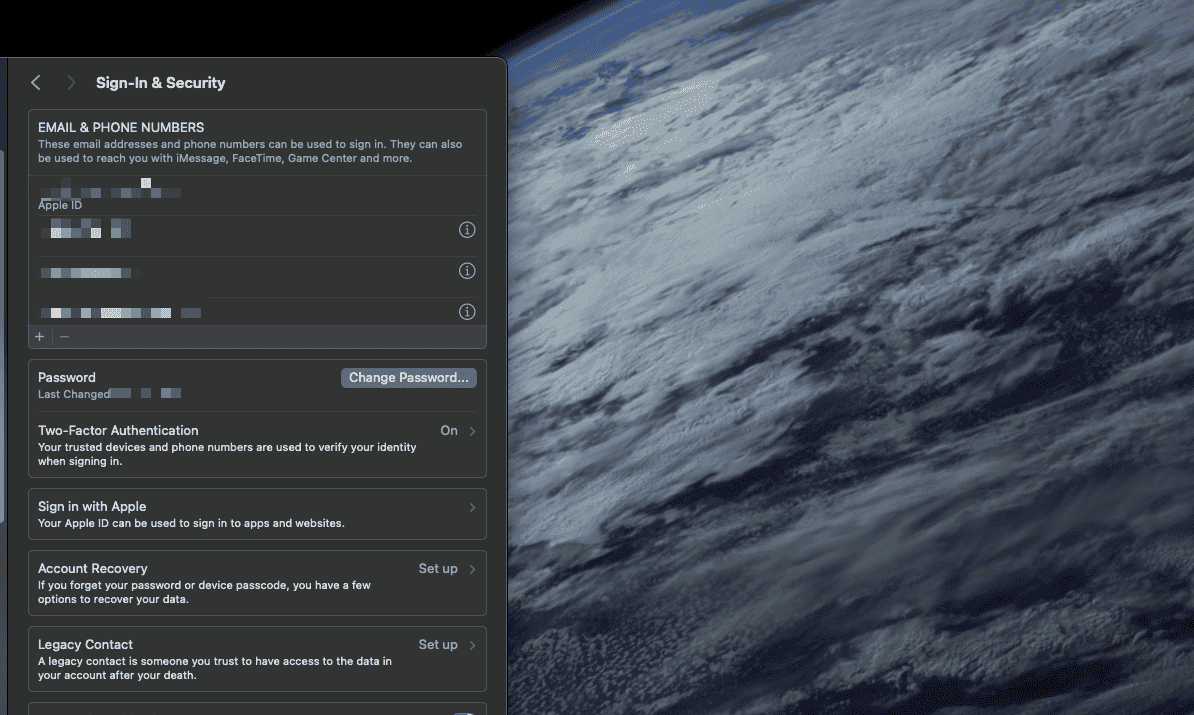
Feb 20, 2024, 1:16 AM
Career Advice for Job Seekers
How to write a standout cover letter

When applying for jobs, cover letters are an easy way to set yourself apart from the crowd and help you move on to the next round of consideration. This doesn’t mean, however, that you should write your cover letter in the same way everyone else does it.
To stand out, you need to give employers something that they can’t find in everyone else’s application —and that means putting together a cover letter that’s tailored to the specific position you’re applying for.
Take a look at this article on how to write a standout cover letter and get started creating your own letter today!
The importance of a cover letter
When looking for jobs, first impressions matter. And sure enough, a professional resume builder can help you create a resume that leaves a lasting impression. But a compelling and well-crafted cover letter will take your application to the next level, giving you an edge against the tough competition. That is why recruiters suggest that, in your cover letter, immediately highlight your strengths and sell yourself. This will grab the reader’s attention and increase the chances of moving to the next round.
While it is true that cover letters aren’t always required, they are still an essential part of the job application process. In today’s job market, a great cover letter is more important than ever. It is your first chance to make a good impression on a potential employer – so it’s worth taking the time to make sure it’s perfect.
7 Main parts of a standout cover letter
Cover letters may have different content, but they all need to have some important elements to serve their purpose. Ideally, they must follow a certain format to keep information organized and easy to identify by employers.
Below are seven sections that cover letters should have to meet employer expectations:
All cover letters have a header that includes your contact details. Applicants usually follow the same header for cover letters to ensure consistency. Regardless of the format, it must include your name, phone number, address, and email address. You may also include links to your social media profiles or portfolio that contain information relevant to the position you are applying for.
2. Greeting
This is the first part of the cover letter that allows you to stand out from other applicants. So, if possible, research the name of the hiring manager to show them that you are serious about your application and that you have put thought and effort into it. You can easily find this information within the job post or on the company website.
3. Introduction
This is the first paragraph of your cover letter. It should contain basic information about yourself and why you want to apply for the role. Mention the job title you are interested in and give an overview of why you are best for the position. You can also mention where you found out about the job posting and why you decided to apply.
4. Qualifications
In this part, you can highlight your work history, skills, and qualifications. This gives the employers an idea of how you can be beneficial to the team. Give some relevant details from your resume, and emphasize your job experience. You can even include stories about relevant scenarios or projects that demonstrate your skills.
5. Goals and values
Here, you may show that you have understood the company’s mission and demonstrate how your goals are aligned with theirs. Share that you aren’t just perfect for the job, but you can also blend in with the team, bringing a positive vibe to the entire workplace.
6. Call to action
This paragraph summarizes your interests and skills. It should also suggest the next steps on how to proceed with your application. Don’t forget to thank the hiring manager for reviewing your application.
7. Signature
Finally, end your cover letter with a professional closing sentence and your signature. Some appropriate phrases to include are best regards, respectfully, with thanks, and sincerely.
Top qualities and skills to include in your cover letter
No matter what industry you’re trying to break into, it helps to have all your bases covered when it comes to your cover letter. The cover letter is one of the most important parts of your job application, as it’s the first thing hiring managers will see in your application package and the only part that’s guaranteed to get a read. Including these qualities and skills in your cover letter will help make sure you stand out from the competition:
1. Leadership
When it comes to qualities and skills to include in your cover letter, leadership is always a great choice. Employers love seeing that you have the ability to take charge and motivate others. To show that you have leadership skills, discuss a time when you led a team or took on a leadership role. Give specific examples of what you did and how your actions made an impact.
2. Time management
If you want to get ahead in today’s business world, time management is essential. No matter what job you have, being able to manage your time well will make you more productive, efficient, and successful. To be a strong candidate for any position, you should mention that you are great at prioritizing tasks and working efficiently to meet deadlines.
3. Teamwork
Whatever industry you’re in or what job you’re applying for, teamwork is always an important skill to highlight in your cover letter. Being a team player shows that you can work well with others and that you’re not afraid to take on new challenges. It also helps when it comes time to working out problems together as a group.
4. Communication
Strong communication skills are essential for any job but especially important for a customer service role. You’ll need to be able to communicate clearly and effectively with customers, answering their questions and addressing their concerns. Good communication skills also come in handy when you are faced with difficult situations. You’ll need to be able to stay calm and professional when things get heated and clearly explain the situation to the customer.
5. Flexibility
One of the most important qualities employers look for in a candidate is flexibility. Being able to adapt to change and handle unexpected challenges is a critical skill in today’s ever-changing workplace. Describe how you have adapted to changing circumstances at work, including changes in workflow, team members, deadlines, or instructions from management. Here are some questions to guide you in showing that you are a flexible team member:
- Have an internship that required you to wear many hats? Talk about what skills you gained through this experience (think creativity, problem-solving, time management).
- Did you take on projects that required new skills? Did these projects allow you to expand your knowledge of an industry or topic?
6. Initiative
One of the most important qualities to highlight in your cover letter is initiative. Hiring managers want to see that you’re the type of person who takes the initiative and doesn’t wait for someone else to tell you what to do.
Here are a few examples of how you can show initiative:
- Volunteering on an office project,
- Arranging a company dinner,
- Proposing ideas at meetings,
- Organizing conferences, or
- Managing projects independently.
Honesty begins when you’re writing a cover letter. It’s important to be honest about your qualifications and skills. After all, you’re trying to convince a potential employer that you’re the best person for the job.
Honesty shows that you’re confident in your abilities and that you have nothing to hide. Plus, it’ll help build trust between you and your potential employer. After all, if you were dishonest in your resume or if you lied during an interview, what’s stopping them from catching on?
It may seem like honesty is a natural part of any profession, but not many people practice it. Don’t be afraid to list every quality and skill that makes you perfect for the position!
Common mistakes when writing a cover letter
One of the most important pieces of your job application is your cover letter. It’s your chance to make a lasting first impression and convince the hiring manager that you’re the right person for the job. But writing a great cover letter isn’t always easy.
To help you get started, here are some tips on how to avoid common mistakes:
Depending on the job you are applying for, being too formal can make or break your application. For instance, if you are writing a cover letter for a renowned firm, then formality is of the essence. But if it is a creative agency you are going for, it may be worth trying to take an informal approach.
Too informal
On the contrary, being too informal can also be perilous. Being too casual or personal may give the recruiters a message that you are not serious about your application. Of course, a conversational tone is ideal, but if you choose to go this way, be sure that you stay professional in some aspects.
Using a template
Using a cover letter template can be efficient and quick. It also allows you to apply to different jobs quickly. But using a template cover letter may suggest laziness or imply that you are not giving effort for that role.
Talking a lot
Unless what you are talking about is necessary for the role you are applying for, there are things that you just have to leave out. Recruiters are often in a hurry, and they want to get an overview of who you are. Yes, it is good to include interests or hobbies. But if you feel they won’t get you the job, just skip them.
Nobody likes people who keep on bragging, not even hiring managers. And the challenge with writing a cover letter is that you need to sell yourself and show off what you can do to land your dream job. However, there is a fine line between confidence and bragging. If you are confident in your HTML skills, simply say you know HTML. As much as possible, avoid making claims that you are an expert in Java or that you have unparalleled leadership skills.
Writing an essay
Keep it short and sweet; they don’t need your life story. Also, avoid phrases like I’m desperate to work with you! and You can count on me.
Not proofreading
Proofread, proofread, proofread! Spelling errors and typos can cost you an interview.
7 Tips to consider to create a cover letter that will land you your dream job
When you’re applying for a new job, your cover letter is your chance to make a great first impression. Here are some tips on how to write a cover letter that will get you noticed.
- Start by introducing yourself and briefly mentioning what you are currently doing, the company or organization you work for, and any other pertinent information.
- Think about what type of position you’re applying for and tailor your cover letter accordingly. If you’re applying for an administrative assistant position, then mention in your cover letter that you have experience with administrative tasks like answering phones and booking flights. If the company needs someone who can work weekends, mention in your cover letter that you have availability during those times and can come in early or stay late if needed to work around the office schedule.
- Share something specific about the position and explain why it interests you.
- Outline your most relevant skills and qualifications in bullet points.
- Be enthusiastic about the company and role—again, be specific about why this particular opportunity interests you more than others out there right now.
- Include a paragraph detailing what makes you unique as an applicant: Maybe it’s because of your excellent communication skills, or maybe it’s because of the customer service training courses that you have taken in the past.
- Customize your application materials to each company: The hiring manager doesn’t know who else might be applying for this position, so they need information about why they should hire YOU specifically. Include what makes YOU stand out from other candidates and why they should invest their time into interviewing YOU as opposed to just anyone else who applied.
A well-written cover letter can be the difference between landing an interview and getting your resume tossed in the trash. Your cover letter should not only showcase your strengths, but it should also explain why you are the right fit for the job and why you deserve to be invited to an interview.
A cover letter accompanies your professional resume when you apply for jobs, so it’s essential that you include only the best information about yourself and your work history in order to snag an interview. However, there are some common mistakes that job seekers make when writing their cover letters, and if you’re making them too, then you’re missing out on opportunities to get the job offer you want. Also, you have to ensure that you include some important qualities and skills in your cover letter to increase your chances of getting called back.
–Dahlia Keen is a certified professional resume writer with over 20 years of experience in the field. Dahlia specializes in career coaching, job search assistance, and professional resume writing. Dahlia is a regular contributor to Resumekit.com , a site dedicated to helping job seekers build an attractive resume.
New Job Postings
Related Articles

How to Write a Cover Letter That Stands Out
Table of contents, introduction.
In the competitive job market, a well-crafted cover letter can be the difference between getting noticed by recruiters and being lost in a sea of applicants. A cover letter serves as a personalized introduction to your resume , showcasing your unique qualifications and demonstrating your genuine interest in the position. In this comprehensive guide, we will explore the art of writing a cover letter that stands out, highlighting its purpose, key components, and providing practical tips to help you create an impactful and compelling cover letter that leaves a lasting impression on hiring managers.
Section 1: Understanding the Purpose of a Cover Letter
1.1 What is a Cover Letter?
A cover letter is a one-page document accompanying your resume during the job application process. It serves as a personalized introduction to your application, allowing you to expand on your skills, experiences, and motivations beyond what is presented in your resume .
1.2 The Purpose of a Cover Letter
The primary purpose of a cover letter is to:
a) Introduce Yourself:
Begin the cover letter by introducing yourself and explaining the position you are applying for.
b) Showcase Your Qualifications:
Highlight your most relevant qualifications, skills, and experiences that align with the job requirements.
c) Demonstrate Your Enthusiasm:
Express your genuine interest and enthusiasm for the company and the position, showing that you’ve done your research.
d) Address Specific Points:
Use the cover letter to address any specific points mentioned in the job description or application requirements.
e) Stand Out:
Differentiate yourself from other candidates and make a memorable impression on the hiring manager.
Section 2: Key Components of an Effective Cover Letter
2.1 Heading and Contact Information
At the top of your cover letter, include your name, address, phone number, and email address. Then, include the date of writing the letter, followed by the recipient’s contact information, such as the hiring manager’s name, job title, and the company’s address.
2.2 Salutation
Address the cover letter to the hiring manager whenever possible. If you don’t have the name of the recipient, use a generic salutation like “Dear Hiring Manager” or “To Whom It May Concern.”
2.3 Opening Paragraph
The opening paragraph is your chance to grab the reader’s attention and create a strong first impression. Mention the position you are applying for, how you learned about the job opening, and a brief introduction of yourself and your background.
“I am excited to apply for the [Job Title] position at [Company Name], as advertised on [Job Board/Company Website]. As a dedicated and results-driven professional with five years of experience in [Your Field], I am eager to contribute my expertise and passion to [Company Name’s] esteemed team.”
2.4 Body Paragraphs
The body paragraphs are the heart of your cover letter. Use them to highlight your relevant skills, experiences, and achievements, while aligning them with the job requirements. Be specific and provide concrete examples to demonstrate your abilities.
a) Address Job Requirements:
Analyze the job description and identify key requirements. Then, provide evidence of how your skills and experiences match those requirements.
b) Showcase Achievements:
Highlight notable accomplishments from your previous roles that demonstrate your value as an employee.
c) Connect with the Company:
Show your knowledge of the company’s values, mission, and recent achievements. Explain how your goals align with the company’s objectives.
“In my previous role as a Marketing Manager at [Previous Company], I spearheaded a highly successful digital marketing campaign that increased website traffic by 35% and generated a 20% boost in lead conversions. I am confident that my expertise in leveraging data-driven insights and my creative approach to campaign development will contribute to [Company Name’s] continued success in the dynamic marketing landscape.”
2.5 Closing Paragraph
In the closing paragraph, reiterate your interest in the position and express your enthusiasm for the opportunity to contribute to the company’s success. Include a call-to-action, inviting the reader to contact you for further discussion.
“Thank you for considering my application. I am excited about the possibility of joining [Company Name] and making a meaningful impact in the role of [Job Title]. I would welcome the opportunity to discuss further how my skills and experiences align with your company’s vision. Please find my resume attached, and I look forward to the chance to speak with you in an interview. Thank you for your time and consideration.”
2.6 Complimentary Close and Signature
End your cover letter with a professional complimentary close, such as “Sincerely” or “Best regards.” Leave space for your handwritten signature, followed by your typed name.
Section 3: Tips for Writing a Standout Cover Letter
3.1 Tailor Your Cover Letter
Customize your cover letter for each job application. Research the company and the position thoroughly to understand their needs and culture. Use this knowledge to personalize your letter and show how you can contribute to their success.
3.2 Be Genuine and Enthusiastic
Employers appreciate candidates who are genuinely interested in their organization. Demonstrate your enthusiasm for the role and the company’s mission, and avoid using generic language that could apply to any company.
3.3 Be Clear and Concise
Keep your cover letter focused and to the point. Avoid lengthy paragraphs or repeating information already presented in your resume. Be concise while providing relevant details that support your candidacy.
3.4 Avoid Repetition
Ensure that your cover letter complements your resume rather than rehashing the same information. Use this opportunity to expand on key points and provide additional context, not to duplicate content.
3.5 Showcase Your Writing Skills
A cover letter is also an opportunity to showcase your written communication skills. Use clear and professional language, and proofread your letter carefully to eliminate errors.
3.6 Quantify Your Achievements
Use quantifiable metrics to make your accomplishments stand out. Numbers and data provide concrete evidence of your impact and can impress hiring managers.
3.7 Use a Professional Format
Stick to a clean and professional format for your cover letter. Use a standard font and keep the layout simple and easy to read. A well-organized cover letter makes a positive impression.
Section 4: Cover Letter Examples
To illustrate the principles discussed, here are two examples of effective cover letters for different scenarios:
Example 1: How to write a cover letter for Experienced Marketing Professional
[Your Name] [Your Address] [City, State, Zip Code] [Your Email Address] [Your Phone Number] [Today’s Date]
[Recipient’s Name] [Hiring Manager’s Job Title] [Company Name] [Company Address] [City, State, Zip Code]
Dear [Recipient’s Name],
I am excited to apply for the position of Senior Marketing Specialist at [Company Name], as advertised on [Job Board/Company Website]. With a proven track record of driving brand growth and customer engagement, I am eager to contribute my expertise and creativity to your esteemed team.
As the Marketing Manager at [Previous Company], I developed and executed innovative campaigns that resulted in a 30% increase in lead generation and a 25% boost in customer retention. Leveraging my strong analytical skills, I identified key market trends, enabling us to refine our marketing strategies and outperform competitors consistently.
I am particularly drawn to [Company Name’s] innovative approach to digital marketing and its commitment to delivering high-quality products that resonate with consumers. Your recent success in launching the award-winning [Product Name] campaign showcases your team’s dedication to excellence, which aligns perfectly with my own values and aspirations.
I am confident that my passion for storytelling, data-driven insights, and cross-functional collaboration will contribute significantly to [Company Name’s] continued growth and market leadership. I am excited about the possibility of joining your dynamic team and driving impactful marketing initiatives that will propel the company to new heights.
Thank you for considering my application. I have attached my resume, and I would be delighted to discuss how my skills and experiences align with your company’s vision in more detail. I look forward to the opportunity of meeting with you for an interview.
[Your Name] [Your Signature]
Example 2: How to write a cover letter for Recent College Graduate
As a recent graduate with a degree in Business Administration from [University Name], I am eager to embark on a fulfilling career journey and contribute my enthusiasm and fresh perspectives to [Company Name].
During my studies, I honed my analytical and problem-solving skills through various real-world projects, including developing marketing strategies for local startups and leading a cross-functional team to organize a successful charity event, raising over $10,000 for a worthy cause.
I am impressed by [Company Name’s] reputation for fostering a supportive and innovative work environment that encourages employees to thrive. Your commitment to sustainability and social responsibility resonates deeply with my values, and I am eager to contribute to [Company Name’s] impactful initiatives.
I am confident that my strong work ethic, adaptability, and eagerness to learn align perfectly with the dynamic and fast-paced culture at [Company Name]. As someone who is passionate about driving positive change, I am excited about the opportunity to contribute to your team’s success.
Thank you for considering my application. I have attached my resume and academic transcripts for your review. I would welcome the chance to discuss how my skills and experiences can complement [Company Name’s] mission in further detail. I am available for an interview at your earliest convenience.
Thank you for your time and consideration.
Writing a cover letter that stands out requires careful attention to detail, genuine enthusiasm, and a clear demonstration of your qualifications. A compelling cover letter can make a significant impact on potential employers and increase your chances of securing the job of your dreams. By understanding the purpose of a cover letter, focusing on its key components, and following the tips outlined in this guide, you can create a standout cover letter that showcases your unique value and paves the way to career success. Remember, your cover letter is your gateway to make a lasting impression – make it count! Good luck with your job applications!
Buildfreeresume.com has a consumer rating of 4.83 stars on Sitejabber .
Introducing John Smith: Your Expert Resume Writer, Cover Letter Specialist, and Career Coach. Meet John Smith, your dedicated partner in crafting the perfect resume, compelling cover letter, and charting your career path to success. With a passion for helping individuals reach their professional aspirations, John brings a wealth of expertise to the table as a resume writer, cover letter specialist, and career coach.
Related Posts

Elevate Your Prospects: Accountant Cover Letter Examples and Templates for 2023 – Download Now
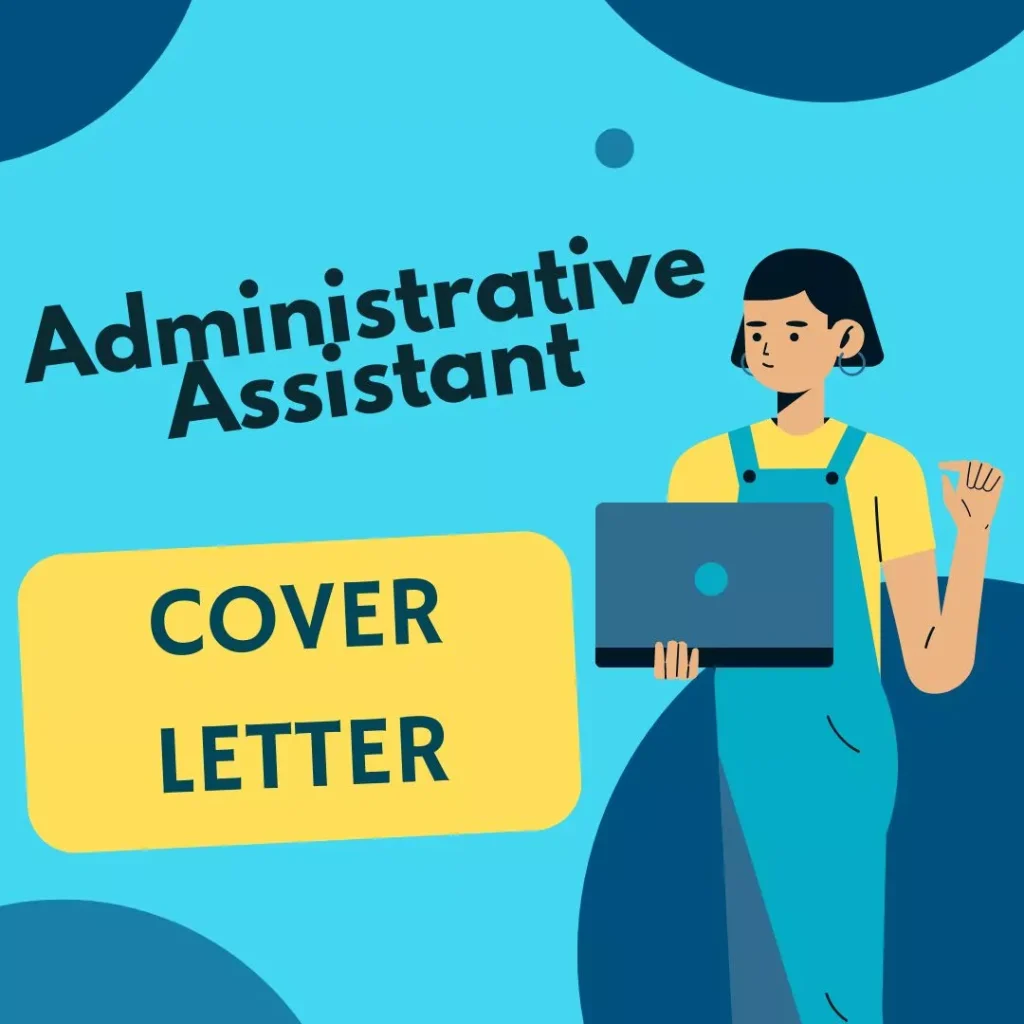
Administrative Assistant Cover Letter Examples and Templates for 2023

A Comprehensive Guide to Writing an Amazing Accounting and Finance Cover Letter

Crafting a Standout Actor Cover Letter: Examples and Tips
Leave a comment cancel reply.
Your email address will not be published. Required fields are marked *
Save my name, email, and website in this browser for the next time I comment.
How to Write a Cover Letter That Stands Out: 3 Steps
By Biron Clark
Published: November 10, 2023
Cover Letters

Biron Clark
Writer & Career Coach
People have a love-hate relationship with cover letters. Most hate writing them. When it comes to hiring managers, some love them and some loathe them. But if you want to make a good impression, you NEED a cover letter that stands out.
In my experience, cover letters get read about half the time when they are not required and 100% of the time when they are.
So it’s definitely important to spend time writing a cover letter that stands out and gets you noticed.
So in this article, I’m going to walk you through the 3 steps you need to write a cover letter that stands out.
How to Write a Cover Letter That Stands Out and Gets You Interviews
A stand-out cover letter contains 3 essential sections , designed to show the reader you’re ideally suited for the role.
Let’s start with the first section that you need in order to stand out:
Step 1: Verbalize the Pain
Use the cover letter to show the reader that you understand the company’s challenges, struggles, etc., and how you are the perfect candidate to solve these issues. In other words, show them that you understand the pain and can make it better.
Pain takes many shapes and forms, from seamless project execution in order to not disrupt business, to building or growing a team to capture market share, launching a new product or service to elevate the brand, to saving money by introducing process efficiencies and automation.
In order to do this, you’ll need to research the company and put yourself in their shoes. Read the job description and think about what they seem to need help with.
That leads us perfectly into the second step of how to write a stand-out cover letter…
Step 2: Examples that Show Pain Solving
Once you’ve effectively shown the reader you understand the challenge or the pain, the next step is to convince them that you are the person who can mitigate it.
If it says they need someone who can work in a fast-paced environment and handle a high workload, then they probably have too much work coming in and are stressed/overwhelmed. Show them that you can ease this burden.
If they say they need someone who can make a great impression on clients to help them grow their business, the best way to write a stand-out cover letter is talk about how you can do this – or better yet – how you’ve done this in the past for other employers.
This should NOT be accomplished by describing yourself with adjectives, but by sharing career highlights that quickly show how you’ve solved similar problems in past roles.
You need to give them real accomplishments, and the more detail, the better. Give facts, statistics, numbers, and results. This is really important when you get to the interview too, so don’t forget this.
(If this is your first job search and you have no past accomplishments you can talk about, read this article on writing a cover letter with no experience ).
Step 3: Moving Past the Pain
Part 3 of a stand-out cover letter should recap your skills and how they can contribute to not just solving pain, but to moving forward to achieve a company’s higher mission, vision or goal.
You need to pull the two previous pieces of your argument together and make your conclusion.
Tell them how their company will improve by having you. What will happen when these problems are solved? Get them excited about a future with you as a part of the company… and show them you’re excited to do the work as well!
The “Secret Weapon” to End Your Stand-Out Cover Letter
After you’ve followed the 3 steps above, you have the main body of your cover letter, and you’ve written it in a way that will stand out to employers and get you interviewed.
But there’s one more thing you should do to stand out further…
You want to finish your cover letter by directly asking for the interview! This seems obvious, but more than 50% of job seekers don’t do this!
So give them your contact details and TELL them to contact you to set up a time to talk. Tell them you’re looking forward to sharing more detail and answering any questions they have about your background, and you’d like to schedule an interview with them to talk further.
This is the final essential piece for how to write a cover letter that will stand out.
Formatting Your Cover Letter Before Sending
So let’s walk through how to format your cover letter well for an electronic format like email:
#1 Contact Information
Unlike a printed cover letter where your contact details must appear at the top, on a digital version, this info should be located below your name in the form of an email signature. Make sure at the very least you include your full name, contact number, email, address, and a LinkedIn URL.
#2 Screen v. Print Reads
Reading online is a whole different ballgame than print reading. In fact, it is much harder. This is in large part due to the fact that our eyes have a tough time digesting dense blocks of text (large paragraphs, long lists of bullets) on a screen.
To ensure smooth online reading of your electronic cover letter, aim for paragraphs that are two to three lines maximum.
Keep this in mind when you format your resume, too, if you expect it to be read in an online format.
A Stand-Out Cover Letter Can be the Difference Between an Interview and a Rejection
Not every hiring manager puts a lot of weight on cover letters, but some do! And when hiring managers require it, then there’s a high probability that they care a lot and use it to decide who to interview.
If you follow the steps above for how to write a cover letter that stands out to employers, you’ll get more interviews and find a job faster.
The following expert contributed to this post:

Virginia Franco is a multi-certified executive resume and LinkedIn writer and founder of Virginia Franco Resumes. She offers customized executive resume and LinkedIn profile writing services for the 21st century job seeker.

About the Author
Read more articles by Biron Clark
Continue Reading
How to Write a Graphic Designer Cover Letter (3 Examples)
How to write a paralegal cover letter (2 examples), how to write a medical assistant cover letter (3 examples), how to write a research assistant cover letter (3 examples), how to write a software engineer cover letter (3 examples), how to write a hr cover letter (4 examples), how to write a data analyst cover letter (3 examples), how to write a bartender cover letter (3 examples).
How to write a cover letter for your CV
If you want to land the best jobs, you need to accompany your CV with a strong cover letter.
In this guide, I will show you how to write a cover letter that will get you noticed by employers and ensure you land plenty of interviews.
Starting with a basic overview…
To write an effective cover letter you must:
- Apply a professional format and layout
- Address the recipient by name
- Explain why you are suitable for the job you are applying for
- Explain why you are applying for the job
- Encourage the recruiter to open your CV
What is a cover letter?
Before you delve into this guide, it’s important to understand what a cover letter is, and what it’s purpose is.
Having a good understanding of these 2 factors will help you to create a really effective cover letter.
A cover letter is simply an introductory note which you send to recruiters and employers, when sending your CV
Here’s an example of a typical cover letter
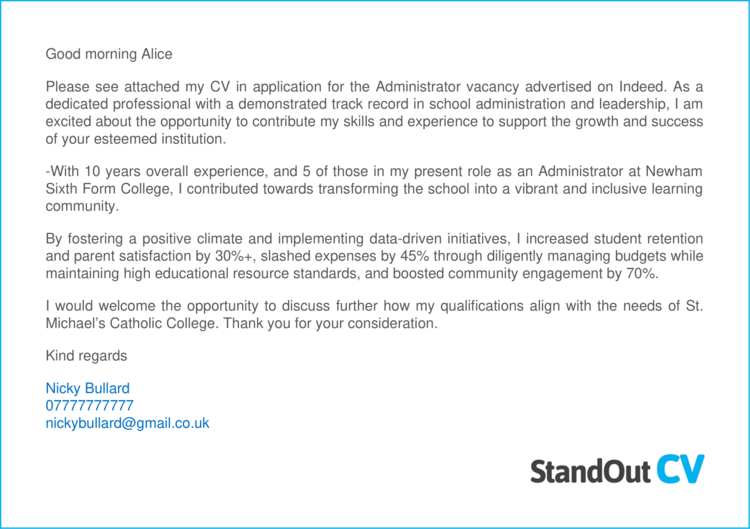
What’s the purpose of a cover letter?
The purpose of your cover letter is to do the following 3 things;
- Introduce yourself
- Build rapport with the recruiter or employer
- Encourage them to open your CV
Cover letter format
Before you start to write your cover letter, you need to understand the basics of formatting one, and the structure to follow.
Using the correct format will ensure that your cover letter is easy for busy recruiters to read, and that you can highlight the important information that they want to see.
Use the following tips to format and layout your CV for best results.
Write your cover letter in the body of your message or email
The number one cover letter formatting rule to remember is, write your cover letter in the body of your email (or messaging box if you are sending via a job website ).

Never attach your cover letter as a separate document.
You want your cover letter to be instantly visible to recruiters and employers, form the moment they open your application.
If you attach it separately, you simply slowing down the process, and run the risk of having your application ignored (especially if it takes a long time for the document to open).
So, always write your cover letter in the body of your application message if you want to make an instant connection with the recipient.
Quick tip: If you are writing your cover letter in an email, use an eye-catching subject line that tailors your skills to the jobs. E.g. Developer with 5 years web app experience

Cover letter layout
Every cover letter will be different of course, but try to stick to this basic layout as much as possible, in order to provide the right information, in a logical order.
This will help you to build rapport with readers, and sell yourself to them in the short window of their attention you have.
Start by addressing the recipient
The first thing you need to do in your cover letter, is address the person you are approaching.

Follow with a friendly greeting
You want to appear professional when applying for jobs, but you also need to be friendly and personable.
So, follow with a friendly greeting such as;
- Hope you’re well
- I hope this email finds you well
Always remember that your message will be read by a real person, and they will appreciate being treated well.
Explain which job you are applying for
Once you’ve greeted and warmed up the recruiter with a friendly opening, it’s time to get to the point.
Let the recruiter know exactly which job you are applying for.

Remember that some recruiters will be working scores of vacancies, so be as specific as you can.
Explain why you are suitable for the job
In the body of your cover letter, you should provide a brief explanation of what makes you suitable for the job you are applying for.
This is ultimately what will encourage a recruiter or hiring manager to open your CV .

I will cover how to do this in more detail in the “W hat to include in a cover letter ” section of the guide.
Sign off in a friendly and professional manner
Remembering that your cover letter is a means of communication with the person receiving it – sign off in a friendly yet professional way.
Use a term like;
- Kind regards
- Look forward to hearing from you
Finish with a professional signature
Finally, at the very bottom of your cover letter, add a professional signature .
This will ensure it looks professional, and provide the reader with instant access to your contact details.

Quick tip: If you are writing a cover letter in email, format your signature to make it look extra-professional, and save it as your default signature for all of your outgoing mails.
How to start a cover letter
To start a cover letter, you should always aim to address the recipient by name – this is the best way to start building rapport.

But you are probably thinking, “How do I find their name??”
There are a few ways you can find the name of the person handling the vacancy
- On the job advert – sometimes the name and email address will be on the job advert itself
- Company website – If you’re applying directly to a company, you can often find the recruitment team or head of department on the company About us section
- LinkedIn – If you can determine the company and team for the vacancy, a search on LinkedIn can often uncover the most likely person to be handling the applications.
“What if I can’t find a name?”
If you can’t find a name, don’t panic – you won’t always be able to.
Simply address the recruiter with the word “Hi” – that’s all you can do in that instance.
Don’t use the phrase “ Dear sir or madam” – It’s very old-fashioned and impersonal.
How long should a cover letter be?
A cover letter should be short and sweet.
The purpose of a cover letter, is simply to persuade recruiters to open your CV, so it doesn’t need to be long .
You only need 3 – 6 sentences to write a good cover letter.
You have to bear in mind that recruiters and hiring managers are busy people, so you need to move them on to opening your CV quickly – or you might lose their attention.
What to include in a cover letter
The content you include in your cover letter will determine whether or not the recruiter is impressed by you, and if they will go on to open your CV.
So, it’s crucial that you include the information they want to see.
Here’s what to include…
Firstly, read the job advert properly
Before you start writing your cover letter, you must ensure that you understand what the recruiter wants from applicants.
Study the job advert carefully, and pick out the most important candidate requirements.
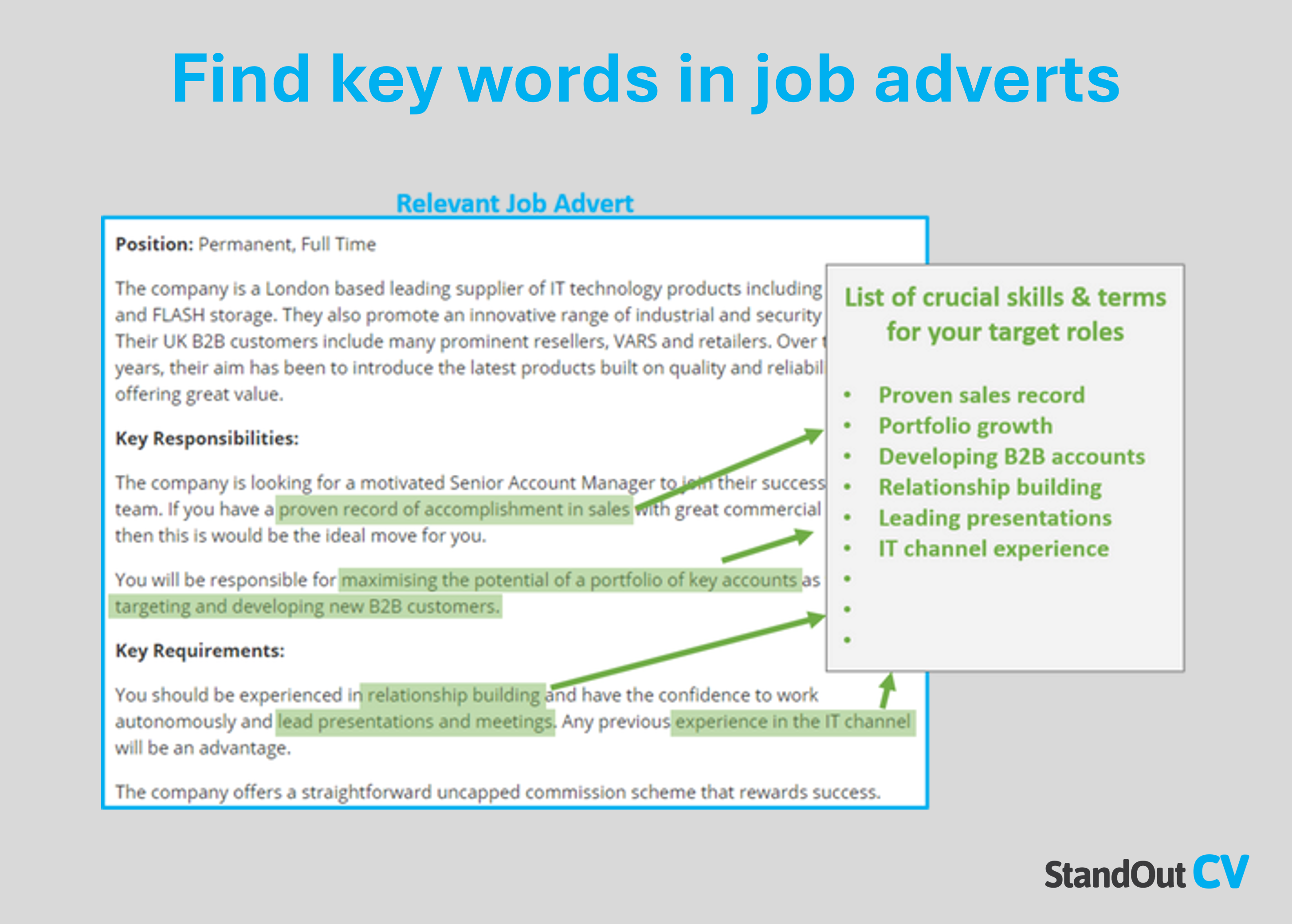
Focus mainly on hard skills such as languages, IT systems, industry experience etc.
Don’t focus on personal skills (such as adaptability, teamwork etc,) as they are needed for most jobs and won’t make you stand out.
Once you know what the recruiter wants from a successful candidate, try to reflect those attributes when writing the below points.
Industry skills
If you’re an experienced candidate, employers will mainly be interested in the work you have done in your industry, tools you are familiar with, type of projects you have worked on etc. so make these a focal point of your cover letter.
If you are less experienced (like a graduate or school leaver) focus on adding transferable skills from your studies, that can be carried over to the workplace.
Length of experience
Recruiters will need to know how much experience you have.
- Are you a graduate?
- Senior with 15 years of experience?
Qualifications
If the role you are applying for requires certain qualifications, then it’s crucial to mention them in your cover letter.
However, if the job advert doesn’t ask for them, or you simply know qualifications aren’t important to perform the role – then you can leave them out.
What you are currently doing
Recruiters will want to know what your current situation is, so be sure to inform them.
- Are you currently working in a similar role?
- Have you just left school?
- Are you immediately available, or do you have to work notice?
Your motivation for applying
One question that recruiters will often ask when they receive an application is, “ why is this person applying for the role ?”
And you need to answer that question in your cover letter.
Your reasons for applying should be positive, and suggest that you are looking to make a firm commitment to the employer.
Do write: “After spending 2 years as senior manager at my current firm, I am looking to take a step up to manage a bigger team in a more specialist market”
Don’t write: “ I’ve recently been fired from my old job, so I need a new one quickly”
Results you’ve achieved for employers
If you’re an experienced candidate, it’s a good idea to allude to the kind of results you have achieved for your current or previous employers.
Maybe you have;
- Saved them money
- Brought on new customers
- Improved processes
- Made plenty of sales
Only give an overview in your cover letter to keep things brief – save the detail for your CV .
How to end a cover letter
To end a cover letter , you should do 2 things; provide a strong call-to-action, and sign of professionally.
Provide a strong call to action
What is a call to action?
It’s simply a request to the reader to take a specific action…
In the case of your cover letter, the action you want the recruiter to take is open your CV.
So it can be helpful to write a line like,
“Please find my CV attached” near the bottom of your cover letter, to encourage readers to do so.
Sign off professionally
Finish your cover letter with a friendly term such as, “kind regards” followed by your name.
Then add a professional signature to the bottom, like the one below;

This makes the cover letter look professional and ensures that recruiters have;
- Your full name
- Phone number
- Email address
Cover letter samples
To give you some ideas and inspiration for writing your cover letter, here are 6 example cover letters .
Customer service cover letter

This customer service cover letter is short and to-the-point – it quickly delivers a host of reasons why this candidate would be valuable in a customer service role.
See also: sales assistant cover letter example
Finance cover letter
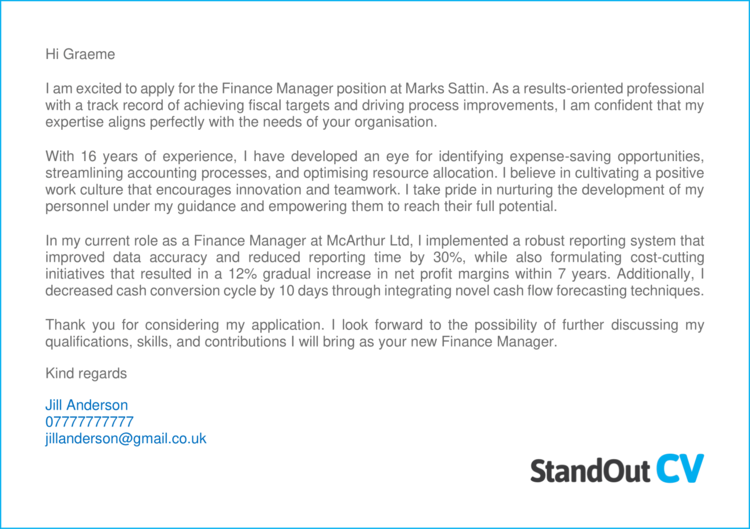
This cover letter outlines the candidate’s finance knowledge, and how they could apply it in the workplace
Graduate cover letter
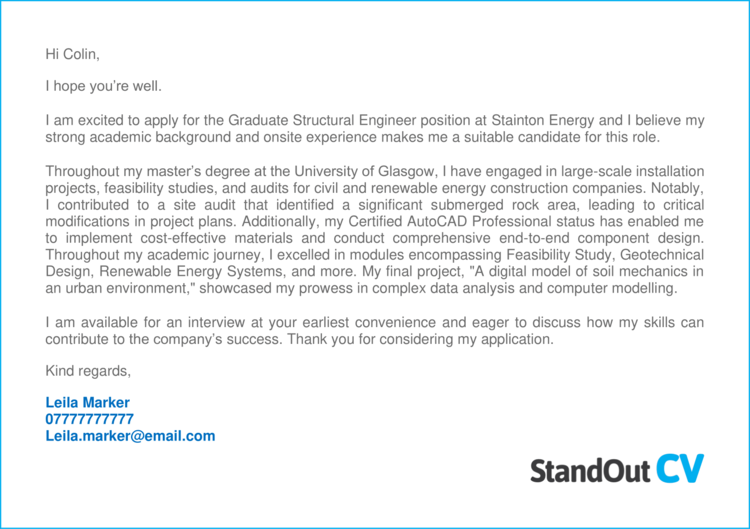
Graduate’s cover letters are a little longer than most, as they don’t have as much experience, so need to describe their education and transferable skills.
Sales cover letter
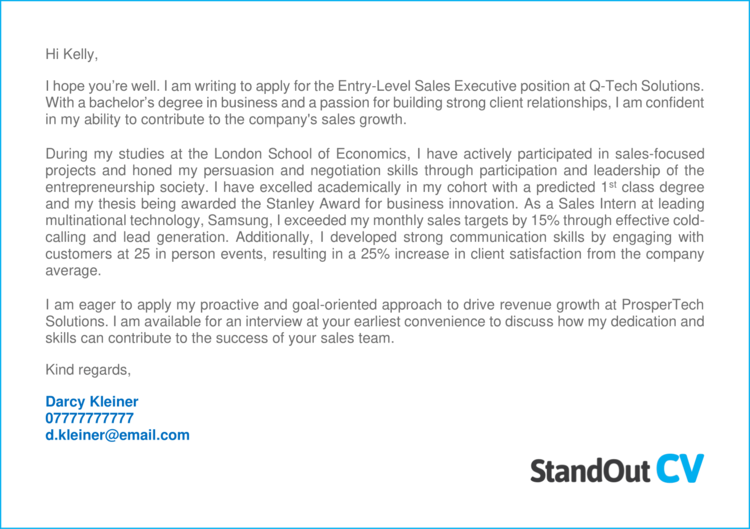
This cover letter boasts the candidate’s ability to make sales and drive revenue.
Project management cover letter
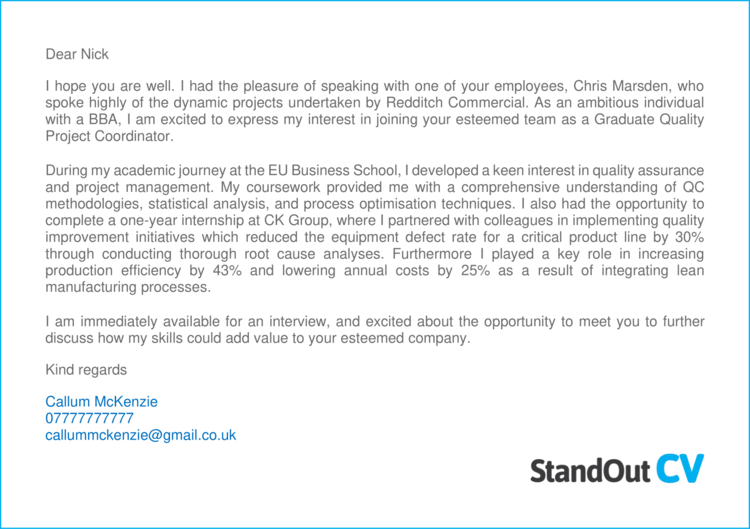
An overview of the candidate’s project manager skills and the types of projects they deliver, are enough to entice recruiters here.
Teacher cover letter
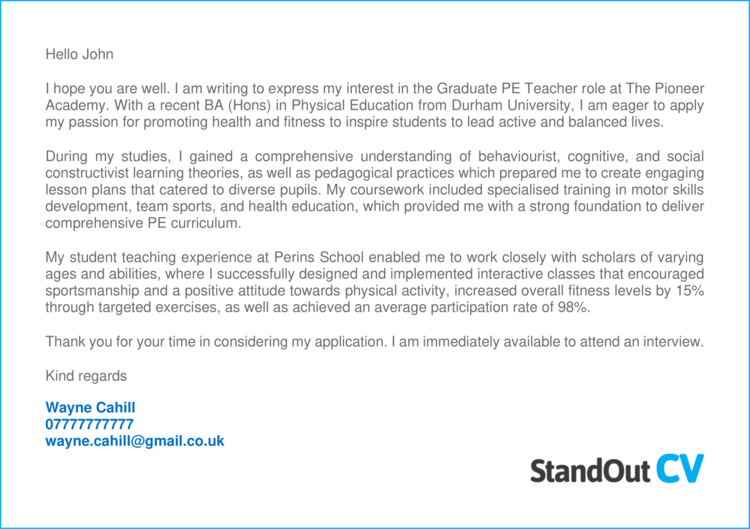
This teacher cover letter provides a brief synopsis of the candidate’s teaching abilities and the types of lessons they teach.
Cover letter mistakes
When writing your cover letter, be sure to avoid some of these common mistakes…
Don’t attach your cover letter as a separate document
You want the contents of your cover letter to instantly greet and connect with the recruiter opening it – so attaching it as separate document will slow that process down.
It doesn’t make sense to attach it as a separate document when you can write in the body of your email or message.
Don’t write a whole side of A4
Your cover letter should be a brief introduction and overview of your suitability for the job.
If you write too much, you risk boring the reader and they might skip past your application.
Save the in-depth details for your CV.
Don’t copy and paste the same cover letter
When your applying for lots of jobs, it can be tempting to simply copy and paste your cover letter into every application.
Whilst this will save you time, it will have a negative effect on your applications.
If you don’t take the time to tailor your cover letter for every job, it’s likely that you will miss some of the key requirements for each job, and therefore you will not make as good as impression as you could have.
It’s OK to work from a template, to keep the structure and some important points that you might repeat for most applications – but always tailor each cover letter to the job spec, for best results.
Don’t use “Dear sir or Madam”
This greeting many have worked well in the 1800’s, but it’s dated and impersonal now.
A simple “Hi” is a friendly and professional way to start your cover letter nowadays.
How to write a cover letter – conclusion
Your cover letter is a crucial tool in the quest to land interviews in the job market.
If you follow the advice above, you should be able to create a concise and powerful cover letter that will excite recruiters, and take you one step closer to landing that dream job
Good luck with your job search!
The 23 Best Cover Letter Examples: What They Got Right
Published: December 14, 2023
I've sent plenty of cover letters throughout my career, so I know it isn't usually fun to write one. Fortunately, the cover letter examples I painstakingly gathered below show that it’s possible to have a little fun with your job search — and maybe even make yourself a better candidate in the process.

I was shocked upon learning 45% of job seekers don't include a cover letter when applying for a job. I definitely don't recommend following the crowd on this matter because your cover letter is a chance to tell the stories your resume only outlines.
It's an opportunity for you to highlight your creativity at the earliest stage of the recruitment process.
![how to write a standout cover letter → Click here to access 5 free cover letter templates [Free Download]](https://no-cache.hubspot.com/cta/default/53/3f347702-d7e9-4e59-9fe4-be4cd7bad191.png)
Are you ready to showcase your unique skills and experience? Or are you looking for more tips and cover letter inspiration?
Keep reading for 20+ cover letter examples, then check out tips for cover letter formatting and what makes a cover letter great .
.png)
5 Free Cover Letter Templates
Five fill-in-the-blank cover letter templates to help you impress recruiters.
- Standard Cover Letter Template
- Entry-Level Cover Letter Template
- Data-Driven Cover Letter Template
You're all set!
Click this link to access this resource at any time.
Cover Letter Examples
- Standard Cover Letter Example
- Data-Driven Cover Letter Sample
- Entry-Level Cover Letter Example
- The Cover Letter That Explains 'Why,' Not Just 'How'
- The 'We're Meant for Each Other' Cover Letter
- The Cover Letter with H.E.A.R.T.
- Short-and-Sweet Cover Letter Example
- The Short Story
- The Bare Bones Cover Letter
- The Breezy Follow-Up
- The Administrative Assistant Cover Letter
- The Internship Cover Letter
- The Brutally Honest Cover Letter
- The Pivot Cover Letter
- The Graphic Design Cover Letter
- Consulting Internship Cover Letter Example
- Nonprofit Referral Cover Letter Example
- General Email Inquiry Cover Letter Example
- Post-Phone-Call Cover Letter Example
- Mission-Driven Graduate Cover Letter Example
- Short Recommendation Cover Letter Example
- Professor or Research Position Cover Letter Example
- Director Cover Letter Example
- Editorial Cover Letter Example
- Promotion Cover Letter Example
- Law Cover Letter Example
Customizable Cover Letter Examples
In a hurry for a cover letter example you can download and customize? Check out the ones below from HubSpot’s cover letter template kit .
1. Standard Cover Letter Example
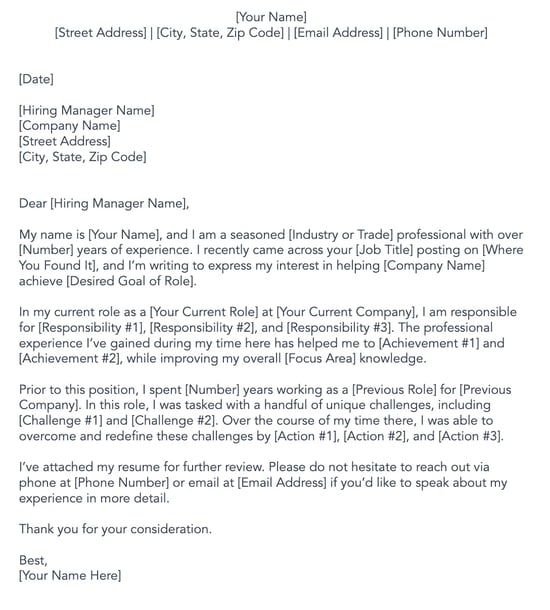
Download a Customizable Copy of This Cover Letter Example
This standard cover letter is among my favorite approaches because it hits all the right notes: It includes a space to give a brief summary of your experience, as well as a space to delve in-depth into the specific responsibilities of your current role.
You also have the chance to describe the challenges you’ve mastered in previous roles, showing that you’re capable of facing any problem that comes your way.
Why I Love It
I love this cover letter because it allows you to describe the high points of your career while still being professional, personalized, and succinct.
2. Data-Driven Cover Letter Sample
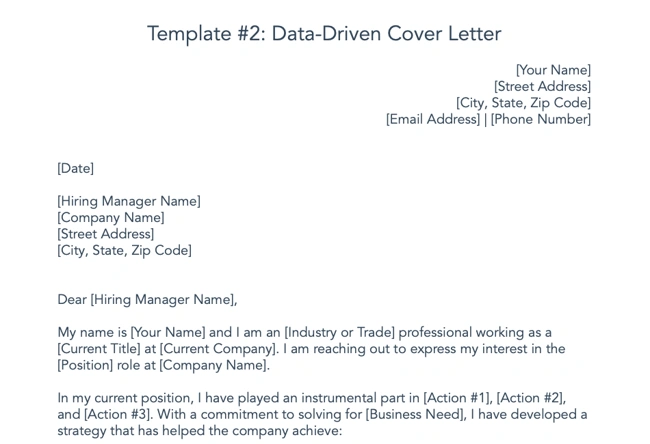
Numbers are worth a million words — or that’s how I think the saying should go (if only we could include pictures in cover letters).
Citing data and statistics about your achievements at your current company is an assured way to capture a hiring manager’s attention.
Over the years, I've learned most hiring managers don’t read the entire letter, so a bulleted summary of your achievements can be a powerful way to increase the effectiveness and scannability of your message.
I love this cover letter because it’s adaptable to any role. Even if you don’t work in a data-centric role, you can include any enumerable achievement.
If I worked in a creative industry, for instance, I could include the number of creative assets you designed for your current company.
3. Entry-Level Cover Letter Example
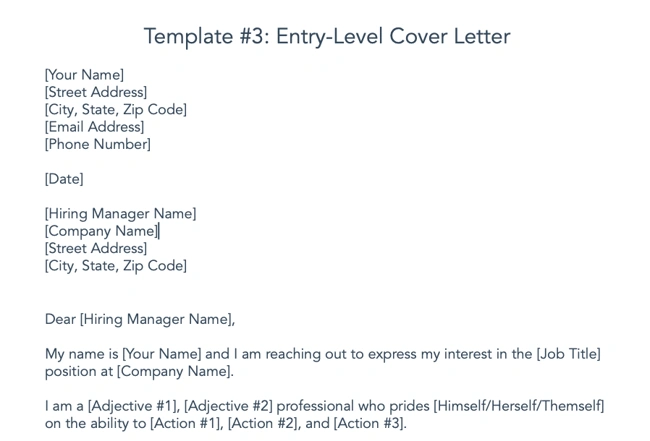
Many of us have had "first job jitters" (that's what I'm calling it) when applying for our first career opportunity.
However, my experience taught me to increase my chances of getting that first interview by including a cover letter that explains how my education can help me succeed in the role I applied for.
In fact, HubSpot staff writer Erica Santiago says highlighting her education was key to snagging her first role out of college.
"When I graduated from journalism school, I only had a couple of internships under my belt and maybe some writing clips — not enough to compete with most young professionals with more experience," she recalls.
"So, I highlighted the classes I took such as 'News Reporting and Writing' or 'Electronic News Gathering," she says, "And I explained the assignments I did and how they gave me real-world experience in interviewing and reporting."
She says that's how she got her first job as a digital journalist for WSVN in Miami.
If you need help understanding how to highlight your education in a cover letter, look no further than this example from HubSpot.
While other cover letter samples give experienced professionals the opportunity to share their experience at length, this one gives you the chance to describe your personal and professional attributes.
You can then convey how you can use your knowledge to help your target company reach its goals.
I love this cover letter because it’s easy and simple to use for a student who has little experience in their target industry — including those who haven’t yet completed an internship.
Looking for more? Download the entire kit below.
5 Professional Cover Letter Templates
Fill out the form to access your templates., best cover letter examples.
What does a good cover letter look like in practice, and how can you make yours stand out? I found six examples from job seekers who decided to do things a bit differently.
Note: Some of these cover letters include real company names and NSFW language that I've covered up.
1. The Cover Letter That Explains 'Why,' Not Just 'How'
You may already know how to talk about how you’ll best execute a certain role in your cover letter. But there’s another question you might want to answer: Why the heck do you want to work here?
The Muse , a career guidance site, says that it’s often best to lead with the why — especially if it makes a good story.
I advise against blathering on and on, but a brief tale that illuminates your desire to work for that particular employer can really make you stand out.

Image Source
Here’s another instance of the power of personalization.
The author of this cover letter clearly has a passion for this prospective employer — the Chicago Cubs — and if she’s lying about it, well, I'm sure that would eventually be revealed in an interview.
Make sure your story is nonfiction and relatable according to each job. While I love a good tale of childhood baseball games, an introduction like this one probably wouldn’t be fitting in a cover letter for, say, a software company.
But a story of how the hours you spent playing with DOS games as a kid led to your passion for coding? Sure, I’d find that fitting.
If you’re really passionate about a particular job opening, think about where that deep interest is rooted. Then, tell your hiring manager about it in a few sentences.
Why This Is A Great Cover Letter
This example shows how effective personalization can be. The writer is passionate about the employer, drawing from her own childhood experience to communicate her enthusiasm.
Further reading: Sales Cover Letter Tips
2. The 'We're Meant for Each Other' Cover Letter
This cover letter example is a special one because it was submitted to us here at HubSpot. What does the letter do well? It makes a connection with us before we've even met the letter's author.
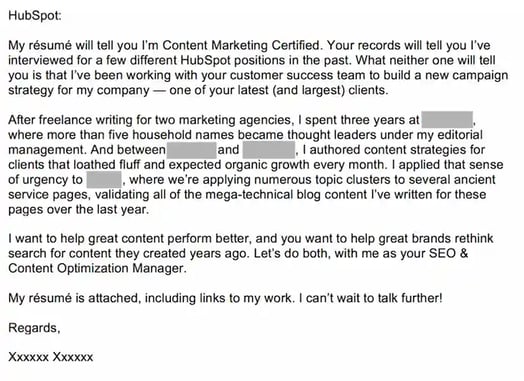
"Content Marketing Certified" shows the applicant has taken the content marketing certification course in our HubSpot Academy (you can take the same course here ).
Our "records" indicate he/she did indeed give an interview with us before — and was a HubSpot customer.
The cover letter sang references to a relationship we didn't even know we had with the candidate.
The letter ends with a charming pitch for why, despite him/her not getting hired previously, our interests complement each other this time around.
(Yes, the applicant was hired).
This cover letter example does an excellent job of building rapport with the employer. Despite not getting hired for previous roles they applied for at HubSpot, the writer conveys exactly why they are right for this role.
Read more: Customer Service Cover Letter Tips
3. The Cover Letter with H.E.A.R.T.
HubSpot has a lot of H.E.A.R.T. — Humble, Empathetic, Adaptable, Remarkable, Transparent.
Our Culture Code is the foundation of the company's culture, the driving force behind our mission to help millions grow better , and serves as the scaffolding for our hiring practices.
Recruiters at HubSpot look for applicants that demonstrate how they embody the Culture Code and job description, paying extra attention to cover letters that are super custom to HubSpot.
In another HubSpot submission, a HubSpot applicant writes about how she found out about HubSpot, why she likes the company, and how her professional experience aligns with H.E.A.R.T.
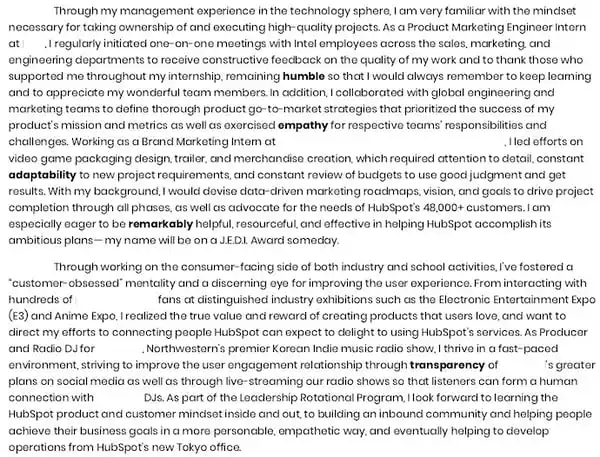
HubSpot's recruiting team was impressed with her dedication to the company and how she went beyond what was asked for by linking her portfolio in her closing paragraph.
Featured Resource: 5 Free Cover Letter Templates
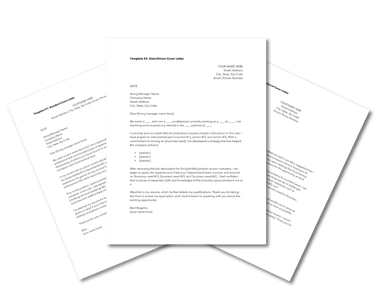
Download our collection of 5 professional cover letter templates to help you summarize your professional journey and land your dream job – whether it's at your first or fifth company.

Short Cover Letter Examples
4. the short-and-sweet cover letter.
In 2009, David Silverman penned an article for Harvard Business Review titled, " The Best Cover Letter I Ever Received. " That letter has three complete sentences, as follows:

One might argue that this particular letter is less than outstanding, and I'll also admit it's an older example.
It’s brief, to say the least, and the author doesn’t go into a ton of detail about what makes him or her qualified for the job in question.
But that’s what Silverman likes about it — the fact that the applicant only included the pieces of information that would matter the most to the recipient.
"The writer of this letter took the time to think through what would be relevant to me," writes Silverman. "Instead of scattering lots of facts in hopes that one was relevant, the candidate offered up an opinion as to which experiences I should focus on."
When you apply for a job, start by determining two things:
- Who might oversee the role — that’s often included in the description, under "reports to." Address your letter to that individual.
- Figure out what problems this role is meant to solve for that person. Then, concisely phrase in your cover letter how and why your experience can and will resolve those problems.
The key to this standout cover letter is research.
By looking into who you’ll be reporting to and learning more about that person’s leadership style, you’ll be better prepared to tailor your cover letter to focus on how you can create solutions for them.
Read here for more tips on how to land your dream job .
5. The Short Story
Basha Coleman began her cover letter with a short story. The goal of this short story is two-fold:
- Detail the experience she already has with the organization.
- Stand out to the hiring team.
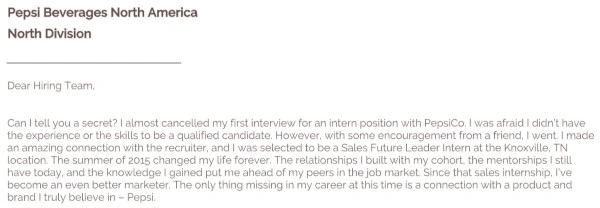
I notice her short story follows a typical narrative arc: It has a conflict/obstacle, a turning point, and a positive outcome, all created with a goal to emphasize a theme or point.
In this case, Coleman is emphasizing her existing affinity with the brand and her triumphs within the program so that she can continue on her career path.
Like the second example in our list, this cover letter does an excellent job of conveying the applicant’s existing affinity for the brand. If you are applying to a company you love, don’t be shy about showing it and explaining why.
6. The Bare Bones Cover Letter
In today's job market, cover letters aren't always necessary. Even though many recruiters won't ask for or even read them, cover letters can still be effective and convey personality to a reader.
Writing a strong cover letter can help you better convey your interest in the position and company.
This template from The Balance Careers puts together the essential components of a short cover letter: excitement about the position, your qualifications, and a call-to-action for the recruiter to follow up with you.
Combining these central aspects in a well-written, compelling narrative will go a long way in convincing readers to hire you.

This letter is organized and concise. The inclusion of bullet points to highlight key skills and help the recruiter skim the document is a nice touch.
Check out this post for more useful cover letter tips .
7. The Breezy Follow-Up
In this cover letter, Amanda Edens is following the instructions the hiring manager gave by forwarding an email with resume and writing samples attached.
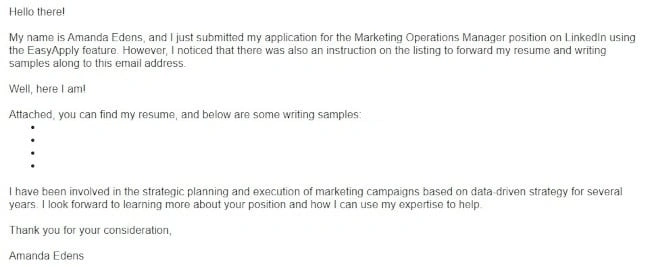
This short cover letter is the result. I especially admire how she uses casual and breezy language to convey personality and enthusiasm, and she keeps her paragraphs succinct.
Not only does Amanda include links to relevant writing samples that are live on the web, but she also closes with a strong final paragraph that:
- Summarizes the expertise she has relevant to the posting
- Emphasizes that she doesn't want to simply get a job but rather help the organization accomplish their goals
- The reader gets everything they need in an organized and thoughtful manner.
8. The Administrative Assistant Cover Letter
In this cover letter the candidate, Michelle, plays up her prior music industry experience to build a connection with Epic Music Group. If you have specific industry experience for the role you are applying for, be sure to highlight that.
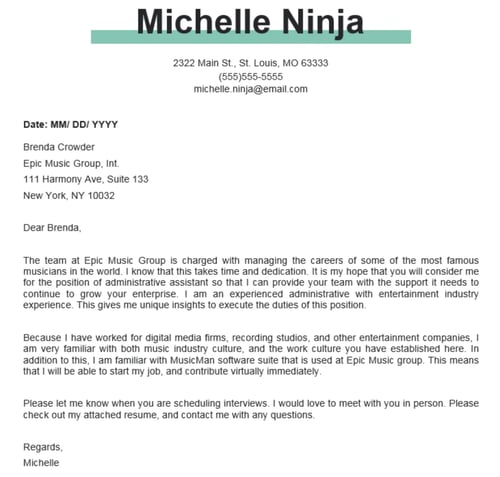
It’s clear that she’s passionate about not only the music industry, but Epic as a whole.
She’s done so much research on the company that she knows what software programs they use, and happens to be proficient in it to help convey value to the hiring manager.
This example further illustrates the importance of research.
Make sure you understand the culture of the company to which you’re applying before you send a completely unfiltered cover letter — if you don’t, there’s a good chance it’ll completely miss the mark.
In just three short paragraphs, the applicant uses their company research to drive home why they are the perfect fit for the role — emphasizing industry experience as well as software knowledge specific to the company.
All of this communicates that she’d be able to start with very few hiccups while getting up to speed.
Further reading: 15 Cover Letter Templates
9. The Internship Cover Letter
Maybe you’re just getting started in your career and looking to land the right internship to gain experience in your field.
In this case, you’ll need to highlight more of your educational background and transferable skills since you won’t have as much professional experience to highlight.

The cover letter above is a great example of how to emphasize your skills and accomplishments when applying to internships or entry-level positions. A few things the applicant does well:
- Highlights relevant extracurriculars and affinity networks. In this case, the applicant is applying for a business analyst position, so mentioning their involvement in a FinTech group makes sense.
- Previous internships in relevant fields: Our applicant points out that they’ve interned as a Business Analyst at another firm. Pointing out that they’ve done the role before will help make their case for fit.
- Highlight other useful skills: This applicant is fluent in both English and German. If an international company or an organization needs bilingual support, knowing multiple languages is an asset.
This cover letter example illustrates how you can leverage your education and background to get the gig even when you don’t have much working experience. Highlighting previous internships or experience in related fields can go a long way in convincing hiring managers you’re the perfect candidate for the role.
Further reading for recent graduates:
- How to Find a Job After College
- Writing a Cover Letter for an Internship
Creative Cover Letter Examples
10. the brutally honest cover letter.
Then, there are the occasions when your future boss might appreciate honesty — in its purest form.
Former Livestream CEO Jesse Hertzberg, by his own admission, is one of those people, which might be why he called this example " the best cover letter " (which he received while he was with Squarespace):
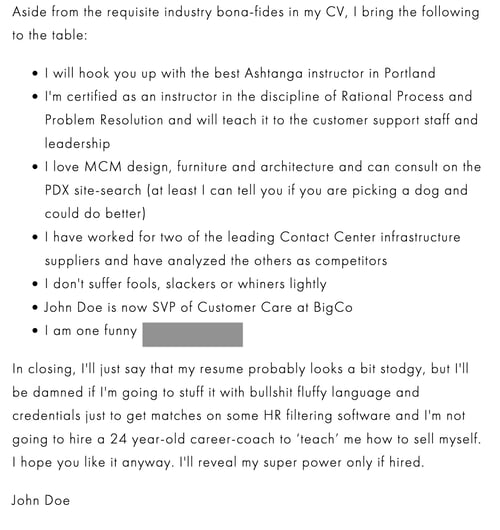
As Hertzberg says in the blog post elaborating on this excerpt — it’s not appropriate for every job or company.
But if you happen to be sure that the corporate culture of this prospective employer gets a kick out of a complete lack of filter, then there’s a chance that the hiring manager might appreciate your candor.
"Remember that I'm reading these all day long," Hertzberg writes. "You need to quickly convince me I should keep reading. You need to stand out."
The applicant did their research on the company’s culture and executed this cover letter flawlessly. It’s funny and shows off the applicant’s personality all while making it clear why they are a good fit for the role.
Further reading:
- How to Stand Out and Get Hired at Your Dream Company
- How to Find Your Dream Job
11. The Pivot Cover Letter
Making a career switch? Your cover letter can be an excellent opportunity for you to explain the reasoning behind your career change and how your transferable skills qualify you for the role.
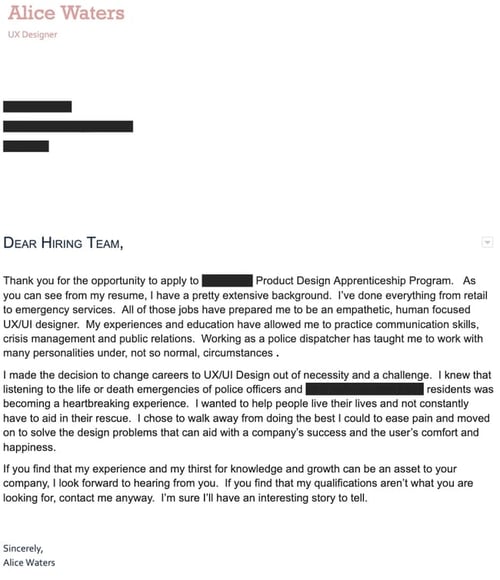
It’s clean but effective.
Since the role she is applying for is more visual, it’s important to both show and tell why you’re a good fit.
This cover letter strikes the perfect balance between creativity and simplicity in design while putting the applicant's career change into context.
The copy is clean, with a creative font choice that isn’t distracting from the content, but still demonstrates the applicant’s knack for design.
12. The Graphic Design Cover Letter
When applying for more creative roles, the design of your cover letter can say just as much as the words on the page. Take the graphic designer letter example below.

It’s got so much going for it:
- Pop of color
- Clean layout
- Interesting fonts
Besides the style elements, this example also doesn’t skimp on the key skills recruiters are looking for. Using metrics, the applicant proves their value and why they would be a great fit.
This cover letter thoroughly conveys the applicant’s skills and qualifications using a variety of visual elements and emphasizing their greatest achievements.
Pro tip: If you're applying for a graphic design job, share a link to your graphic design portfolio website , even if it's not an application requirement.
Job Cover Letter Examples
Next up, let’s go over some classic cover letter examples for jobs, especially if you’re applying to internships or only have a few years of experience.
The below cover letters follow the golden rules and don’t deviate too much from the standard — which is ideal if you’re applying to positions in more traditional industries.
13. Consulting Internship Cover Letter Example
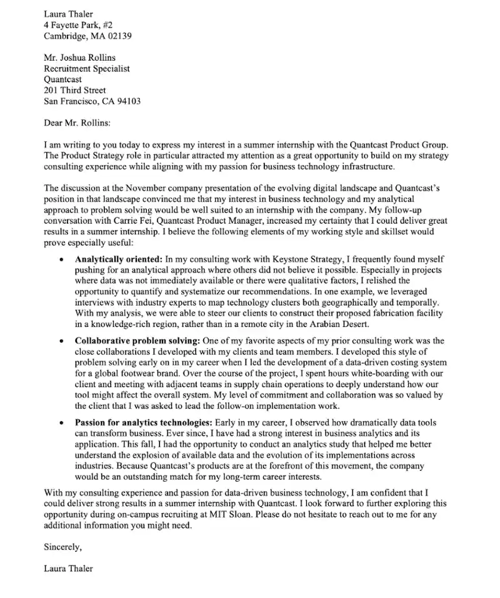
Many internship applicants are early on in their careers or are still in college. That means they’ve yet to gather enough experience to offer tangible proof of their ability to do the job.
That means that a cover letter is the place where an internship applicant can shine.
This cover letter example highlights the applicant’s skills in a bullet-point format. That makes it easier for an overburdened hiring manager to get the essence of her points, quickly, if they’re only skimming cover letters.
Not only that, but this applicant personalized the letter in every single sentence. She shares information about her prior conversations with some of the company’s employees and mentions the company’s name at every turn.
While she only has one prior consulting job, she deftly mentions the skills she developed in that role and ties them into her desired position at Quantcast Product Group.
This cover letter example does a fantastic job advertising the applicant’s soft skills in a highly scannable format — while still going heavy on the personalization.
Don’t be shy to lightly play with formatting to get your point across and to imbue the letter with your passion for a company.
14. Nonprofit Referral Cover Letter Example
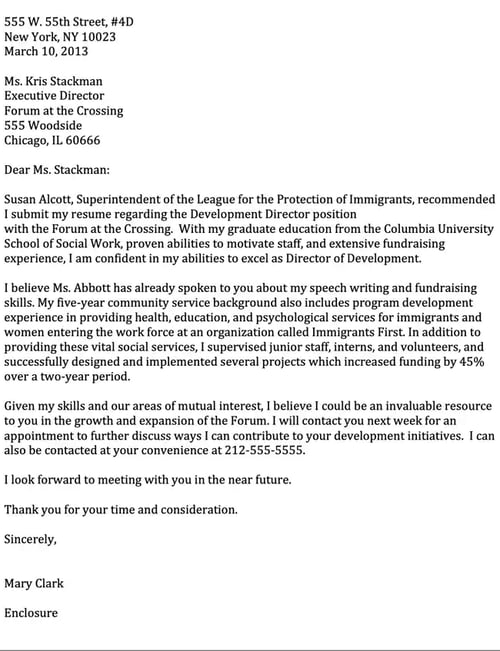
This cover letter example for a nonprofit job hits the ground running by right away inserting the name of one of the nonprofit’s Superintendents.
That’s an excellent way to get a recruiter’s attention and make you stand out from the slush pile, even if you’re only just out of school, as is the case for this applicant.
If you’ve received an internal recommendation for a position, you’d be wise to open your letter with that information. Don’t worry about it feeling too stilted or strange — remember, hiring managers only skim letters.
Your goal is to make sure they get information about you that they otherwise won’t get from your resume.
With only three full paragraphs, this cover letter example is short, sweet, and to the point. No time is wasted, and it also goes over the critical basics, such as skills and experience.
This nonprofit cover letter includes a recommendation from an internal employee at the target organization, making it more likely to stand out from the slush pile.
I also love that it doesn’t skimp on the basics, such as skills, enthusiasm, and experience.
15. General Email Inquiry Cover Letter Example
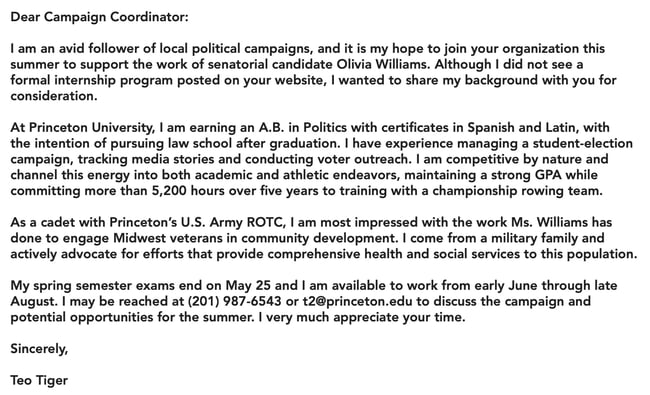
Even if a job opportunity isn’t available at an organization yet, it doesn’t mean that there won’t be. You can always send a general inquiry cover letter, like the one in this example.
This email cover letter for a political campaign internship is short and sweet, but includes the critical information the campaign coordinator needs to consider the applicant for any new positions that may open up.
The best part about this cover letter is that it can be easily customized from one political campaign employer to the next.
While it does include a level of personalization, it’s brief and can be easily changed to address the specific political candidate.
When sending general inquiries like this one, it’s essential to make the personalization aspect as pain-free as possible for yourself. That may mean including only one sentence or two, knowing that a general inquiry might not be replied to.
This email cover letter example hits all the right notes while keeping it brief and to-the-point. While we don’t recommend choosing this format for a formal cover letter, it works if you’re sending a general inquiry to an employer over email.
It’s also a good example to follow if you’re still in college or have very little experience.
Read more: How to Write a Letter of Interest
16. Post-Phone-Call Cover Letter Example
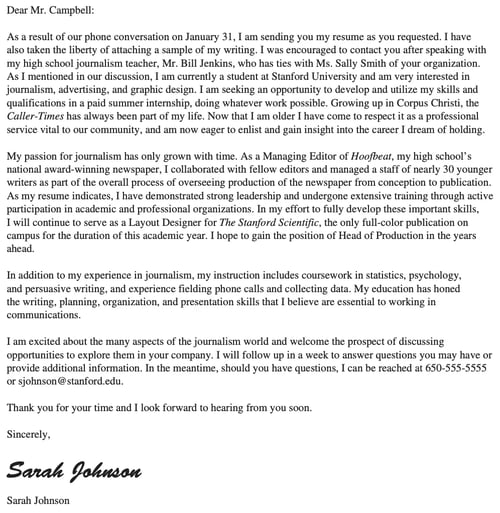
If you get a phone call from a potential employer and they invite you to send your resume, pat yourself on the back — that is such a win. In your cover letter, be sure to mention that right away, like this example does.
A hiring manager or an executive at a company likely has a lot of tasks on their plate, which means that they may forget about your call from one week to the next.
That is totally okay, which is why this example starts with a reminder that the applicant and the letter recipient spoke back on January 31st. It also has a few more details about why they started speaking in the first place.
Aside from leveraging the phone call that’s already occurred, this cover letter also does an excellent job explaining why the applicant is an ideal choice for the job.
It goes into detail about skills and previous experience with a high level of enthusiasm, and includes a promise to follow up at the end.
This cover letter example includes two things that will immediately draw my attention: A phone call they’ve already had, and a mutual contact at their organization.
The job and internship search can be grueling; never be afraid to use everything you have at your disposal to improve your standing over other applicants.
Read more: How to Start a Cover Letter
17. Mission-Driven Graduate Cover Letter Example

This cover letter example from a recent B.A. graduate wowed me from the first sentence.
The applicant right away explains her attained degree and her specific career interests, then dives into the aspects of her experience that make her such a great candidate.
It's so personalized to the employer’s own mission that it’s difficult to stop reading it.
Even if the hiring manager isn’t a science or health professional, they would be able to effectively gauge the applicant’s suitability for the role by the expertise she shows in her cover letter alone.
The applicant explains at length why she’s excited to work for that specific hospital. The organization serves Aboriginal populations, which aligns with her own values and research interests.
In the last paragraph, she summarizes what she knows about the employer in one sentence, then describes how each of her experiences supports the employer’s mission.
That is an exceedingly clever and meaningful way to align yourself with an organization at a deeper level.
If you’re applying to a mission-driven organization, don’t be shy about showing your excitement and expertise. You don’t need a lot of experience to show that your values align with those of your target organization.
This cover letter example is especially good inspiration if you’re making a career change, have only just a few internships under your belt, or are graduating from college.
18. Short Recommendation Cover Letter Example
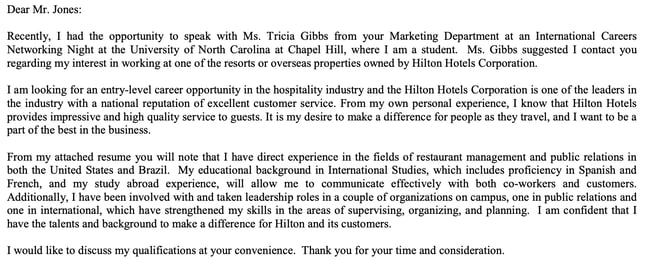
Referral or recommendation cover letters don’t need to be too long, and this is a great example of that. It immediately leverages a mutual connection at the company.
The mutual connection recommended that the applicant contact the hiring manager for a role, which is a piece of information I always recommend you frontload in your letter.
This specific cover letter comes from an applicant with little experience, making it a good example to follow if you’re switching careers or just out of college.
Instead of talking about their experience, the applicant uses anecdotal evidence to convey their enthusiasm for working at that company.
The writer also goes over their most salient skills, such as being able to speak multiple languages. They also explain how their degree directly applies to the target role.
I love that the candidate highlights their leadership abilities and makes that an effective selling point for being hired.
This cover letter doesn’t go on for too long, which we love. It’s simple and sweet and provides all the information the hiring manager needs to look more closely at the applicant’s resume and make an interviewing decision.
19. Professor or Research Position Cover Letter Example
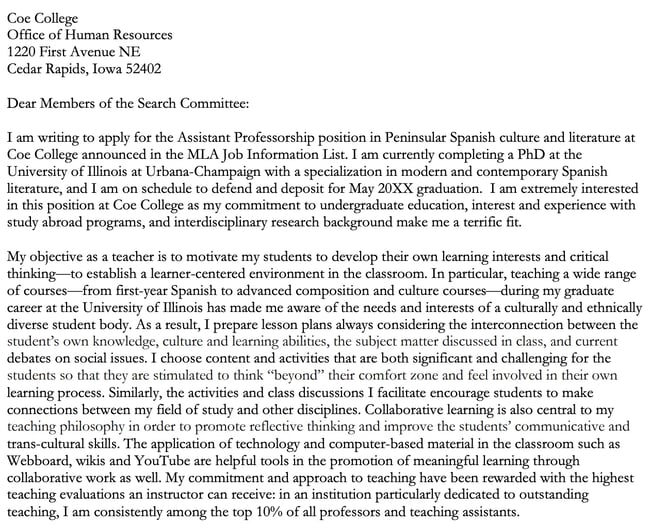
Academic or research position cover letters might require a little more information than the typical cover letter — and this is one such example. Why is it okay to go a little longer?
Because the letter is not only a way to supplement the PhD candidate’s academic CV, but to provide a writing sample for the search committee.
I love this cover letter because it expresses the candidate’s enthusiasm for teaching and explains her instructional ethos, such as providing out-of-the-classroom opportunities, championing communication, and encouraging students to step out of their comfort zone.
The applicant also suggests courses she may be able to teach at the target institution, and expresses her interest in developing new courses as needed.
She also suggests how she can enhance the college’s extracurricular programming by offering study abroad courses, which shows not just an interest in teaching but adding to the school’s overall culture.
While this letter goes for a little longer than recommended, it serves as a fantastic writing sample and explains the applicant’s research background at length.
If you’re applying to academic or research roles, don’t be afraid to go into detail about what most excites you in terms of research interests.
20. Director Cover Letter Example

This cover letter example — for a Director of Catering position at a university — doesn’t waste any time.
The applicant right away says that they’re a strong candidate for the role, then jumps right into three salient qualifications that make him a great fit.
I love how the applicant uses bullet points and bold text to guide an overburdened hiring manager through the cover letter — and to give them permission to scan it, if needed.
If the hiring manager would like more information or actual examples of the skills, they merely need to read the rest of the bullet point paragraph.
As mentioned, light formatting can be beneficial to your cover letter, as it draws the recruiter’s eyes and prevents them from having to fish for the information they’re looking for.
This short, sweet cover letter includes the critical information a hiring manager or high-level executive needs to make an interview decision.
I love the use of formatting that doesn’t stray too much from regular cover letter conventions, and I like that the applicant kept all other paragraphs extremely brief.
21. Editorial Cover Letter Example

Applying for an editorial or journalistic position? Like a cover letter example I shared earlier, you can take a more storytelling approach to capture the hiring manager’s attention.
This cover letter example does that effectively by telling an anecdote that directly mentions the newspaper where they’d like to work.
This immediately draws the reader in and tells them that this application isn’t random at all; the applicant would like to work at the newspaper because they’ve read it every morning.
Not only that, but they have a favorite reporter on the newspaper’s staff. The applicant then jumps into the specific reason they want to take an editorial position at the Baltimore Sun.
The cover letter includes all pertinent information, such as how previous positions have equipped the applicant to take on this job. It closes with enthusiasm after keeping the reader rapt every step of the way.
The applicant uses storytelling to — you guessed it — apply for a position that needs storytelling skills. If you’re applying for a data-driven position or a graphic design position, why not showcase those skills in the cover letter itself?
I like that this letter doesn’t diverge too much from cover letter conventions while still differentiating itself.
22. Promotion Cover Letter Example
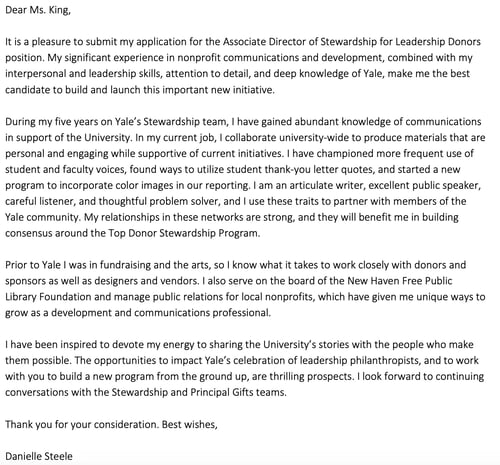
In this cover letter example, the applicant already works for the employer and wishes to apply for the next position to move up in their career.
I like that the letter cites the applicant’s extensive knowledge of the organization, which will no doubt give them an advantage over external applicants.
Not only that, but the applicant also references their experience before they started working at the employer and uses that information to make their candidacy even more desirable.
Lastly, this letter includes a healthy level of enthusiasm for the university and the position — something that is never extra in a cover letter.
This cover letter example does an excellent job showing the candidate’s knowledge of their current organization while stating why they’re a natural fit for the promotion.
Plus, the letter includes information on the applicant’s relevant activities outside of work — if you’re involved in any organizations that might help you do your job better, be sure to include them.
23. Law Cover Letter Example
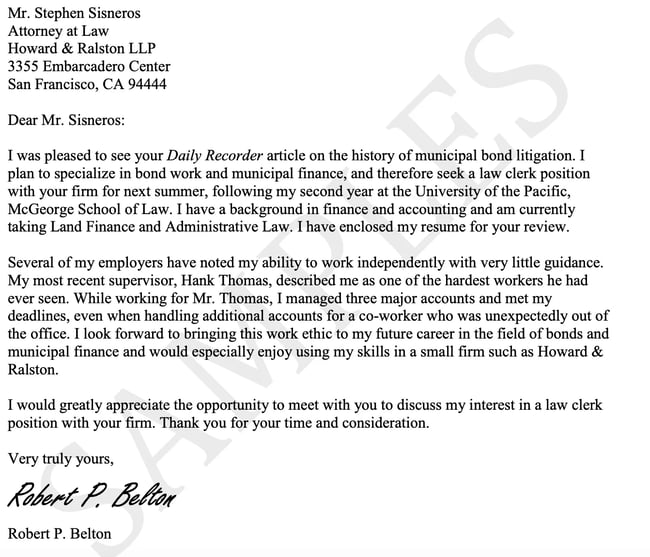
This law cover letter example jumps right into personalization, a bold move that will serve you well if you’re genuinely interested in a company and want to stand out.
The applicant cites the recipient’s recent article on bond litigation, then ties that into the role they’d like to get at the law firm.
The applicant then goes into his skills and the feedback he’s received from past managers. This is an excellent way to introduce your skills without sounding dry — or even unfounded.
By citing positive feedback you’ve received, you’ll imply that others have praised you for having those skills, and that you’re not only "tooting your own horn."
Pro-Tip: In cover letters, it’s absolutely okay to toot your own horn — that’s what they’re for. But if you can cite others’ remarks, that also helps.)
At just two and a half paragraphs, this letter is exceedingly short but no less effective. It’s an excellent example of how to personalize your letter quickly while still conveying the essentials of a cover letter.
This short cover letter example keeps it brief while still creating high impact. The applicant personalizes the letter immediately, cites external feedback, and conveys enthusiasm.
This letter proves you don’t need to write a novel about an employer to sway the hiring manager into giving you an interview.
Now that I've shown you some excellent examples, let's talk about how you can create the best cover letter for your dream job.
What is a good cover letter?
A cover letter is used to show your interest in the role, passion for the company, and the impact you've had in previous positions. Good cover letters should include a standout opening, relevant skills and qualifications, and a strong finish with a call-to-action — all within one page and unique to each application.
What’s on a cover letter?
Before you start writing your cover letter, let's cover a few basic must-haves you'll want to include. If you’re looking for more detailed instructions, check out this guide to writing a cover letter .
Add a simple, but pleasant greeting to address the recruiter or hiring manager.
Learn more:
- Dear Sir or Madam Alternatives
- Cover Letter Greetings
Write a catchy introduction that explains why you’re interested in the role.
- How to Write an Introduction
- Tips for Writing a Good Introduction Sentence
Work Experience
This is the heart of your cover letter. It outlines your relevant experience and why you’d be a great fit for the role. You can highlight special skills, experiences, professional achievements, or education to help make your case.
- How to Write About Your Professional Background
- Professional Bio Examples
- LinkedIn Bio Examples
In this paragraph, add a call-to-action by expressing interest in an interview. Offer your contact information and sign off.
- Email Closing Line Examples
- Tips for Writing Conclusions
What does a cover letter look like?
Besides showing off your skills and qualifications, cover letters give you the opportunity to present a clear, concise, and compelling writing sample. It shows off your personality and your ability to convey ideas.
That's a lot of information to include on a single page, so it can help to have a clear structure to start with.
Check out our fillable cover letter templates to see how you should organize the content of your cover letter.
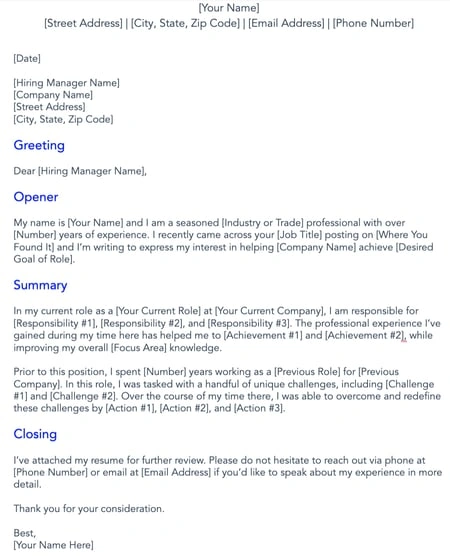
What makes a great cover letter?
A cover letter is personal, but it also needs to help you reach a goal and help the hiring team understand how you could perform that role with their company. This complexity can make cover letters really tough to write.
Because cover letters are difficult to write, many come off as boring, basic, or confusing for hiring managers to read. But the tips below about the qualities that make a cover letter great can help you take your cover letter from basic to bright.
Start with this quick video, then keep reading for more tips:
Personalized Introduction
Begin with an introduction that's personal. It should capture the reader's attention and address your recipient by name. Then, add a compelling opening sentence that emphasizes your interest in the specific role.
Helpful Cover Letter Introduction:
"Dear [Hiring Manager's Name],
In an increasingly digitized world, where customer-centric strategies are vital for business success, I am thrilled to apply for the [Job Title] position at HubSpot."
Unhelpful Cover Letter Introduction:
"To Whom it May Concern,
I am applying for the [Job Title] position at HubSpot. I have some experience in marketing and can help your clients grow their businesses."
Relevant Professional Experience
It can be tempting to use the same cover letter for every job. After all, it's about your experience, isn't it? But it's not enough to rephrase the work history in your resume.
Recruiters and hiring managers are looking to fill a specific role, so you need to show how your experience translates to their unique needs.
So, the body of a great cover letter should showcase the specific professional experiences that are relevant to the job you're applying for. Emphasize your accomplishments and skills that directly relate to what the job needs.
To speed up this part of the cover letter writing process, start by creating a list of your transferable skills . Drafting this list can help you quickly focus on the skills to highlight in your cover letter.
Then, use AI tools to summarize job descriptions and narrow in on where your experience and the needs of the role you're applying for overlap. This post is full of useful AI assistant tools if you're new to AI.
Helpful Cover Letter Experience:
"At [Company Name], I had the opportunity to assist a global ecommerce retailer in enhancing their online customer experience. By conducting in-depth market research and customer journey mapping, I identified pain points and areas of improvement in their website navigation and user interface."
Unhelpful Cover Letter Experience:
"I also worked with an ecommerce retailer to improve the customer experience. We did some surveys and training, and they were happy with the results."
Useful Examples
To make your cover letter stand out, add specific examples that show how you've solved problems or gotten results in past roles.
Quantify your accomplishments whenever possible, using data to give the reader a clear understanding of your impact.
Helpful Cover Letter Example:
"I lead a team of five content writers while increasing website traffic by 18% year-over-year."
Unhelpful Cover Letter Example:
"I have a great track record of leadership and achieving fantastic results."
Research and Company Knowledge
Hiring teams aren't hiring anyone with the skills to do the job. They're hiring a person they'll work alongside at their specific company.
So, to show that you're not just looking for any job anywhere, share your knowledge of the company's industry, values, and culture in your cover letter.
Spend some time on the company website and take notes on what makes this business interesting to you and why you would want to work there.
Then, explain how your skills align with the company's mission and goals and explain how you could add to their chances of success. This will showcase your interest in the company and help them see if you are a good cultural fit.
Helpful Cover Letter Research:
"I was particularly drawn to HubSpot not only for its industry-leading solutions but also for its exceptional company culture. HubSpot's commitment to employee development and fostering a collaborative environment is evident in its recognition as a top workplace consistently. I strongly believe that my passion for continuous learning, self-motivation, and dedication to contributing to a team will make me a valuable asset to HubSpot."
Unhelpful Cover Letter Research:
"I have been inspired by HubSpot's commitment to inbound marketing and its comprehensive suite of solutions. HubSpot's dedication to providing valuable content and fostering meaningful relationships aligns with my own values and aspirations."
Clear Writing
Your cover letter needs to pack in a lot of important information. But it's also important that your cover letter is clear and concise.
To accomplish this, use professional but easy-to-understand language. Be sure to remove any grammar or spelling errors and avoid lengthy paragraphs and avoid jargon or overly technical language.
You may also want to use bullet points to make your letter easier to skim. Then, proofread your cover letter for clarity or ask a friend to proofread it for you.
- Guide to Becoming a Better Writer
- Tips for Simplifying Your Writing
Helpful Cover Letter Writing:
"In addition to my academic accomplishments, I gained valuable practical experience through internships at respected law firms.
Working alongside experienced attorneys, I assisted in providing legal support to clients. This hands-on experience helped me develop a deep understanding of client needs and enhanced my ability to effectively communicate complex legal concepts in a straightforward manner."
Unhelpful Cover Letter Writing:
"Furthermore, as a complement to my academic accomplishments, I have garnered invaluable practical experience through internships at esteemed law firms.
Throughout these placements, I actively collaborated with seasoned attorneys to conduct due diligence and furnish clients with comprehensive legal support. Notably, these experiences fostered a profound comprehension of client necessities, whilst honing my legal acumen to articulately convey intricate legal principles within a lucid and concise framework, adhering to applicable precedents and statutes of limitations."
Genuine Interest and Enthusiasm
Find ways to convey your passion for the role and how excited you are to contribute to the company you're applying to. At the same time, make sure your interest feels authentic and outline how it aligns with your career goals.
Your ultimate goal is an enthusiastic letter that feels honest and leaves a lasting positive impression.
Showing excitement in writing doesn't come naturally for everyone. A few tips that can help you boost the genuine enthusiasm in your letter:
- Record audio of yourself speaking about the role, then use voice-to-text technology to transcribe and add these sections to your letter.
- Choose your words carefully .
- Write in active voice.
Helpful Cover Letter Tone:
"I am genuinely enthusiastic about the prospect of joining [Company/Organization Name] as an accountant. My combination of technical proficiency, eagerness to learn, and strong attention to detail make me an ideal candidate for this role. I am confident that my dedication, reliability, and passion for accounting will contribute to the continued success of your organization."
Unhelpful Cover Letter Tone:
"Honestly, I can hardly contain my excitement when it comes to reconciliations, financial statement analysis, and tax regulations! Engaging in spirited discussions with professors and classmates has allowed me to foster an unbreakable bond with the fascinating world of accounting, and I'm positively bursting with enthusiasm at the prospect of applying my skills in a professional setting."
Memorable Conclusion
End your cover letter on a strong note. Summarize your top qualifications, restate your interest in the position, and express your interest in future communication.
Then, thank your reader for their time and consideration and include your contact information for easy follow-up.
To make your conclusion memorable, think about what parts of your letter you'd most like the hiring manager to keep top of mind. Then, consider your word choice and phrasing. If you're feeling stuck, this list of ways to close an email can help.
Helpful Cover Letter Conclusion:
"Thank you for considering my application. I am excited about the opportunity to further discuss how my qualifications align with the needs of Greenpeace. Please feel free to contact me at your convenience to arrange an interview.
Together, let's make a lasting impact on our planet.
[Your Name]"
Unhelpful Cover Letter Conclusion:
"Thank you for considering my application. I look forward to the possibility of discussing my qualifications further and how I can contribute to Greenpeace's mission. Please feel free to contact me at your convenience to arrange an interview.
I’d like to add another stage to the job search: experimentation.
In today’s competitive landscape, it’s so easy to feel defeated, less-than-good-enough, or like giving up your job search.
But don’t let the process become so monotonous. Have fun discovering the qualitative data I’ve discussed here — then, have even more by getting creative with your cover letter composition.
I certainly can’t guarantee that every prospective employer will respond positively — or at all — to even the most unique, compelling cover letter. But the one that’s right for you will.
So, get inspired by these examples and templates. Write an incredible cover letter that shows the hiring team at your dream job exactly who you are.
Editor's note: This post was originally published in October 2020 and has been updated for comprehensiveness. This article was written by a human, but our team uses AI in our editorial process. Check out our full disclosure to learn more about how we use AI.

Don't forget to share this post!
Related articles.

Is a Cover Letter Necessary in 2024?
![how to write a standout cover letter How to Write a Cover Letter for an Internship [Examples & Template]](https://blog.hubspot.com/hubfs/Copy%20of%20Featured%20Image%20Template%20Backgrounds-Aug-21-2023-02-03-52-3390-PM.png)
How to Write a Cover Letter for an Internship [Examples & Template]
![how to write a standout cover letter Letter of Interest Tips, Templates & Examples [A 2023 Guide]](https://blog.hubspot.com/hubfs/letter%20of%20interest.png)
Letter of Interest Tips, Templates & Examples [A 2023 Guide]

15 Cover Letter Templates to Perfect Your Next Job Application

The Ultimate Guide to Writing a Cover Letter
![how to write a standout cover letter How to Start a Cover Letter to Impress Employers [+ 14 Examples]](https://blog.hubspot.com/hubfs/how-to-start-a-cover-letter.jpg)
How to Start a Cover Letter to Impress Employers [+ 14 Examples]

Eight Cover Letter Greetings for Every Situation

7 Expert Cover Letter Tips to Get the Job
Marketing software that helps you drive revenue, save time and resources, and measure and optimize your investments — all on one easy-to-use platform
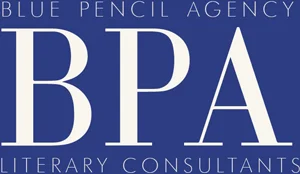
- Editor’s Reports
- Reader’s Report
- Short Report
- Submission Package
- Copy-Editing
- Scriptwriting
- Intro to Literary Agent
- Online Tutorials and Q&A
- 2023 Weekend Workshops
- BPA Pitch Prize 2023
- BPA Pitch Prize 2022
- BPA Pitch Prize 2021
- BPA Pitch Prize 2020
- BPA Pitch Prize 2019
- BPA First Novel Award 2023
- BPA First Novel Award 2022
- BPA First Novel Award 2021
- BPA First Novel Award 2020
- BPA First Novel Award 2019
- BPA First Novel Award 2018
- BPA First Novel Award 2017
- Join Our Mailing List
- Peggy’s Blog
- Blog Archives
How to Write a Stand-Out Cover Letter
- How to Write a Stand-Out…

SO, WHAT IS A COVER LETTER?
Literary agents and many literary competitions require a cover letter along with your sample chapters and synopsis. This is a formal introduction to you and your novel. Note: It is not a CV, a bio or a blurb for the book. It’s a letter, written from one professional to another, that should make the agent or judge want to read more. The biggest mistake entrants to the BPA First Novel Award made this year was getting the balance off, either writing too much about the novel or too much about themselves – some poor novels didn’t get a mention. There’s a rough template most agents and competition judges will look for, and it’s pretty doable! Let’s give it a go.
TELL US ABOUT THE NOVEL
First, tell us about the novel. That’s what you’re trying to sell! You want the agent to finish the cover letter with such curiosity about the book that they’re hungry for the sample chapters.
The first paragraph will usually reveal the title , the genre , the word count of the completed manuscript (If you don’t include this, they might worry you haven’t finished it!) and something that offers a taste of the novel, like a mention of the themes you’re going to explore.
Be specific when stating the genre – if it’s general fiction, think about whether the market is commercial, book club, upmarket or literary. If it’s YA, don’t just say it’s YA – is it a YA romance? YA dystopia? Who’s out there writing YA crime? The literary agent will be familiar with all the terms, so the more specific you are, the easier it will be to picture an audience for the book.
Once you’ve provided these core facts, write an elevator pitch . This is a single sentence that conveys your novel’s hook or USP. For inspiration, check out the Sunday Times Bestsellers List:
- Richard Osman’s The Thursday Murder Club : Four friends in a retirement village team up to solve a mystery on their doorstep.
- Paula Hawkins’ The Girl on the Train : A commuter’s fascination with a married couple she passes every day turns deadly.
It’s a good idea to follow this up with a one-paragraph description of the novel. Unlike the synopsis, it doesn’t need to tell the entire story, but it should be just more than the premise. Tell us who the protagonist is, what happens to upset the balance of their life, and what their goal is (presumably to restore said life balance!). If you can do that in a couple of sentences, you might also mention one of the novel’s core turning points.
Cover letters should describe the novel first, then the writer, then remind us of the novel at the end. In a short final paragraph, say what inspired you to write the book and offer some comparable titles . (Check out agent Nelle Andrew’s advice on comparable titles .)
The letter should be targeted towards the literary agent or competition judge you’re writing to. Some writers choose to open with this and others incorporate it into the later paragraphs. The best way to make a connection and show you’ve done your research is to mention an author on the agent’s list who has a relevant readership. You could also explain why you think your novel aligns with what they describe in their wish list.
TELL US ABOUT YOU
It’s the writing, not the writer, that’s important … but the agent or judge does want to know about you too. They especially want to know why you were the one person who could write this book . And it’s true – no one else could write the book you’ve written. So tell us why. Did your job as a psychiatrist inspire the analysis of your antagonist’s motivation? Do you live in the idyllic town where the book is set? Have you studied the era of your historical novel? Share relevant details about yourself.
The agent or judge also wants evidence that you are a writer. You’re not just someone who thinks they have a novel in them; you take your craft seriously. If you can, share what magazines your short fiction has been published in, the competitions you’ve been listed in or the creative writing courses you’ve completed. If you don’t have that kind of experience, share anything that tells us you’re serious. Join a writer’s workshop group and tell us about that. Attend an online masterclass (like the ones BPA runs ) and mention that. Experiment with writing in different forms and tell us about it. S hare which contemporary authors have inspired you, so it’s clear that you’re well read. Just don’t put, ‘This is my first attempt at writing fiction,’ and leave it at that. It doesn’t inspire confidence.
A cover letter should be professional, like the cover letter you would send with a job application, but you also want it to have some personality. And given you’re basically applying for the role of ‘novelist’, it needs to be well written.
So, keep it formal, make sure it’s eloquent, and try to get some flow into it. When you read it aloud, it should sound natural. If it doesn’t, it might be that you haven’t varied sentence length, that you’ve used rigid language, or simply that you’re trying too hard. As formal as a cover letter should be, you want your enthusiasm for this novel you’ve spent so long writing to imbue the lines.
COMMON ISSUES IN ‘BPA FIRST NOVEL AWARD’ SUBMITTED COVER LETTERS
- Formatting it like a CV or splitting it into sections titled ‘Bio’ and ‘Novel Summary’.
- Sharing irrelevant detail about your personal life.
- Making it too short – 200-350 words is a good guideline.
- Or too long – unfortunately, nobody’s going to read a cover letter past the first page!
- Writing a vague description of the story e.g. ‘When a mysterious event happens, a woman will have to look to the past to uncover the truth.’
- Including long-winded explanations of why there’s a huge market for your book.
- Coming across as arrogant … or lacking in confidence.
- Sharing more about the novel’s message than its story.
WRITE THE COVER LETTER YOUR NOVEL DESERVES
Once you’ve finished a manuscript, the instinct is to get it on submission as soon as possible, but it’s worth taking the time to give an accurate and exciting representation of the work . Literary agents receive many submissions a day and have to fit reading time in with a huge workload. You need to grab them in the cover letter so that they’re already thinking of you as a potential client when they read the sample.
Out of everything you could have written on the blank pages of a document titled Novel , you’ve carefully chosen each word of this story that has to be told. You know people will love it and you hopefully have a sense of who and why . Get that across to the agent or competition reader, and maybe, just maybe, they’ll request the full manuscript.
For personalised feedback on your cover letter, you might want to consider a BPA Submission Package Report – enquire here .

Related posts

SUBSCRIBE NOW!
More than 10,000 subscribers
Your information is never shared with third parties
THANK YOU FOR SUBSCRIBING!
How to Write a Standout Cover Letter 2023
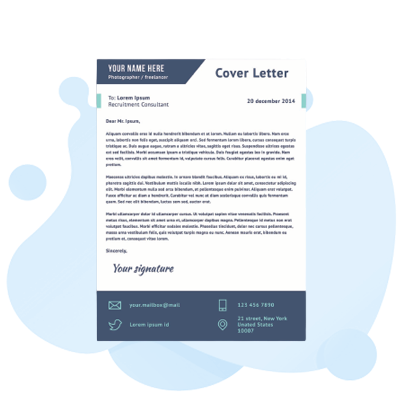
If you want to be noticed by a recruiter, you need to create a stellar cover letter. You can do this by paying attention to the first few sentences. A lot of cover letters open with a generic introduction, so it is important to make your opening paragraph stand out. If the opening paragraph is boring and unimpressive, it will be nearly impossible for a recruiter to read your cover letter.
Free Cover Letter Practice Test Online
Cover letters questions and answers.
98% of the time, a cover letter should be included with your job application. Although they might not always read it, recruiters anticipate that applicants will submit one. Your chances will improve greatly, and you will stand out from other applicants with comparable qualifications and resumes if you include a cover letter.
- Start by conducting research. Learn more about the business and the position you want before you begin to write.
- Concentrate on the future. According to Glickman, your cover letter should be more future-oriented than your resume, which should reflect your experience and wherever you’ve been.
- Make a strong opening. “People frequently include a statement like, “I’m applying for X job that I saw in Y place. ” in their cover letters. Lees argues that it is a waste. Instead, start with a powerful sentence. Glickman advises, “Start with the punch line — why and how this job excites you and what you bring to the table.”
- Emphasize your value. Managers who are hiring are seeking candidates with problem-solving skills. Show that you are knowledgeable about the business’s operations and some of its difficulties by drawing on your earlier research.
- Exhibit enthusiasm. Glickman states, “When you don’t get hired, it’s usually not for lack of skills.” It’s because people didn’t believe your account, that you desired the position, or that you were aware of what you were entering. The applicant who has presented themselves as having this position as their dream job will be chosen by hiring managers.
- Pay attention to the tone. However, be careful not to overdo the flattery or say anything unintentionally. Genuineness is essential. Even if you’ve been jobless for months and would accept any position, Lees advises against coming across as desperate. Be mature and professional to avoid having your tone detract from your message.
- Make it brief. Much of the advice out there advises keeping it to one page or less. But Glickman and Lees concur that even shorter is preferable. According to Lees, “Most cover letters I see are too long.” “It should be concise enough for someone to read it quickly.
- Get opinions. In fact, according to Lees, it’s a great idea to give a few people a copy of your cover letter. Be specific about the feedback you want rather than sending it out and asking, “What do you think?”
Ideally, your cover letter should be between 250 and 400 words long, or three to six paragraphs.
A cover letter is crucial because 26% of recruiters read them and regard them as essential when hiring.
A letter of introduction attached to or included with another document, such as a resume or curriculum vitae, is known as a cover letter, cover letter, motivational letter, or letter of motivation.
Although they are listed as optional on the application form, 77% of hiring managers still prefer applicants who submit a cover letter because they believe it is important to their hiring decisions.
Use “Dear Mr./Miss Last Name” if you know the hiring manager’s name; otherwise, use their full name if you don’t know their gender, marital status, or preferred pronoun. It is more polite to address the recruiter by their title if they hold a professional or academic one.
You shouldn’t double-space cover letters. In your cover letter, add a blank line between each section.
Half-page to one full page is the recommended length for cover letters. A page is a maximum length for your cover letter.
Use common cover letter fonts like Arial, Calibri, or Helvetica, and set the font size to 11–12 points to format a cover letter correctly. The margins should be one inch wide on all sides. The cover letter’s line and paragraph spacing should be 1.15-1.15 inches apart.
Some hiring managers and recruiters will read your cover letter before moving on to your resume. You probably don’t know the strategy that hiring individuals for the position you want will use. As a result, spend some time writing a cover letter whenever you can.
Capitalize proper nouns at all times. A proper noun in a job title should always be capitalized. If a job title is used to describe a job, it should not be capitalized.
A cover letter cannot be longer than two pages. A cover letter over two pages will likely lose the hiring manager’s interest. If your cover letter exceeds one page, it indicates that it is not narrowly focused and that you are beginning to ramble.
Your cover letter should serve as a persuasive essay that explains to the employer why you are a strong candidate for the position.
- Information about you.
- Contact Person’s Name, Title, Employer, and Address.
- Salutation.
- Opening Paragraph.
- Middle Paragraph.
- Second Middle Paragraph.
- Contact Information and Closing.
A professional closing salutation, such as “Sincerely,” “Best regards,” or “Thank you for your consideration,” should be used after expressing gratitude for their time and consideration. Stay away from overused words and phrases like “Yours,” “Cheers,” and “Take care.”
Instead of just restating what is on a resume, cover letters should elaborate.
They are almost always, yes. Although it’s not strictly required, according to 83% of recruiters, a well-written cover letter gives you a chance to demonstrate why you’d be a great fit for the position you’re applying for.
An address is not required for cover letters. Cover letters used to include both the applicant’s and the recipient’s addresses because they were typically mailed or delivered in person. Physical addresses are no longer required because cover letters are now primarily submitted electronically.
Yes, most of the time. Because a cover letter demonstrates two crucial factors, including that the applicant has gone above and beyond, many employers prefer to see one.
Always use proper titles and left-justified spacing in your cover letter.
You don’t have to disclose any irrelevant details, private information, or anything else that doesn’t relate to the position you’re applying for.
The application cover letter, the prospecting cover letter, and the networking cover letter are the three main varieties of cover letters.
Despite the aforementioned, you should only send a cover letter if you have pertinent information to share your resume doesn’t cover that.
In addition to making the first impression on a potential employer, your resume provides that.
Your cover letter should be customized for each position and business, just like your resume.
Therefore, a cover letter for an internship is crucial and an important component of your application materials.
Yes, a cover letter should be included with your resume.
Recruiters might be more likely to read cover letters for a more important position, but most respondents believe they are no longer necessary.
Keep your cover letter in one space. In the heading, a space should be left between addresses and dates.
Parts of your cover letter can be reused when applying for similar positions at different companies. The company information should be updated for each letter, but failing to do so is a serious offense.
It’s likely that only the human resources staff at the company where you’re looking for work will read your cover letter. If you have previously submitted a cover letter to the business, it is almost certain that you have plagiarized one of their previous submissions.
Applicant tracking systems will scan your submitted resume and cover letter to look for keywords that match the job posting.
Yes, a header is necessary for a cover letter. Your name, email address, and phone number should be listed in the cover letter header.
No, your cover letter does not need to include a date.
No, a cover letter does not require your signature. However, adding a signature to your cover letter demonstrates a higher level of professionalism and attention to detail, which can help you make a good impression on potential employers.
- Research the company and job.
- Use the hiring manager’s name.
- Connect your values to the company.
- Share your professional goals.
Notably, sending your cover letter as a PDF has several generally acknowledged benefits over doing so as a Word document: People believe PDFs appear more professional. There won’t be any font or formatting issues with PDFs. Almost any operating system can use PDFs (unlike Word documents)
A cover letter, also called an application letter, is a three- to four-paragraph memo to employers outlining your interest in the position, the company, and your suitability for the position.
- Explain how your accomplishments relate to the position.
- Emphasize how the employer needs your skills and work experience.
- Demonstrate genuine enthusiasm and delight for the position.
- List your career’s most noteworthy accomplishments.
- Describe your qualifications for the position to the recruiter or employer.
Verdana, Times New Roman, Arial, and Calibri are the most widely used options. It’s preferable to stick with a single typeface and set the font size to 12 pt.
- Beginning with a standard greeting.
- Excessive friendliness.
- Only considering what the business can provide for you.
- Selling yourself short.
- Using a template after copying it.
If the job offer specifies that a cover letter is included, if the company, hiring manager, or recruiter wants one, if you are applying directly to a specific individual and are aware of their name, or if you have been recommended for the position, a cover letter is crucial and necessary.
The hiring manager for the position you’re looking for should always be the recipient of a cover letter. Use the recruiting manager’s first and last name unless you are certain the organization has a more relaxed attitude.
Some hiring managers and recruiters will read your cover letter before moving on to your CV. You probably don’t know the strategy that hiring individuals for the position you want will use. As a result, spend some time writing a cover letter whenever you can.
Writing the cover letter normally takes the most time because it’s viewed as the hardest piece of the job application to prepare.
Hiring managers will only view your resume for the first 40 seconds and typically read your cover letter for only the first 30 seconds. Therefore, you must make it simple for the eye to locate the important information.
To present oneself to potential employers and entice them to study your resume is the primary function of a cover letter. It also seeks to peersuade them that you are the best candidate for the job.
Additionally, given workers’ current power in the labor market, cover letters might soon become obsolete. Over 13,000 professionals were polled in a recent Fishbowl by Glassdoor study, and 58% of respondents thought cover letters were unnecessary. Only 10% of professionals believe they are essential when looking for work.
No, according to some recruiters. In the end, your cover letter is “your one opportunity” to stand out and highlight the unique qualities you bring to the job that you can’t adequately express in your resume or online profile. Interestingly enough, cover letters might now be more crucial than ever.
Include a cover letter with your CV since most job postings require one.
You have a bigger chance of being called for an interview with a well-written technical cover letter. You can position yourself as the ideal candidate with the IT abilities and technical knowledge that the tech company is looking for.
Unless they contain proper nouns, all majors should be written in lowercase.
The cover letter should be in a conventional business format and no longer than one page. This means that you are free to indent your paragraphs or not, but leaving them out creates a little extra space.
Compared to a cover letter sent on paper, one sent in the email body is shorter. A mailing address, date, or signature are not required.
If the addressee is truly anonymous, use the form of “Dear Hiring Manager” when addressing a cover letter. Remember that the traditional cover letter salutation is “To Whom It May Concern.”
Choosing the appropriate tone for a cover letter is one of the hardest obstacles. You want to project a professional yet positive attitude. While showcasing your outstanding abilities and accomplishments, you don’t want to come across as arrogant.
Graphic Design Cover Letters
Developing a powerful graphic design cover letter is an important part of the job search process. It’s your chance to showcase why you’re a great fit for the job. There are a few key tips you should keep in mind. These tips will help you write a compelling cover letter. Moreover, you’ll be able to differentiate yourself from other applicants.
First, make sure you’ve researched the company and the position you are applying for. It’s vital to make your cover letter relevant to the position you’re applying for, otherwise, it’ll be ignored. Also, make sure you include relevant information and skills. Make sure you highlight your Adobe Creative Suite skills, conceptual design skills, and other essential skills.
Once you’ve created a solid resume, your next step is to write an impressive cover letter. The goal of this document is to start a conversation with the employer. The cover letter is your opportunity to show them why you’re the best candidate for the position. A cover letter is a great way to highlight your personality and explain your background.
Nano Letters Cover Art
Nano Letters is a peer-reviewed, monthly publication by the American Chemical Society. It covers all aspects of nanotechnology and nanoscience. Nano letters are intended for science, technology, and business professionals. Each issue contains original research on cutting-edge nanotechnologies and nanoscience. In addition, the magazine publishes interviews with scientists, engineers, and other professionals who are involved in the field. The cover art for each issue is different, but they all have a common theme: science and technology.

Executive Assistant Cover Letters
When writing an executive assistant cover letter , it’s important to highlight your skills. Hiring managers want someone who can solve problems and multitask effectively. Highlight your achievements within the industry and demonstrate how well you communicate. You can also highlight any awards or special recognition you have received. In addition to highlighting your qualifications, make sure to tailor your letter to the job description.
When writing an executive assistant cover letter, you should focus on the most relevant achievements and career experiences, and not repeat what you have already written in your resume. A cover letter gives you more space to showcase your skills and personality and may even land you an interview. A cover letter also highlights transferable skills such as time management and project management.
Your cover letter should be one or two pages long and contain three to four paragraphs. It should highlight your experience and skills, and emphasize your interest in the position. The hiring manager will be reading through hundreds of applications and sift through yours, so make sure your content is unique and compelling.
Cover Letters for CNA Positions
If you’re applying for a CNA position, you’ll want to write a compelling cover letter that catches the employer’s attention right away. A good way to do this is to use a personal story. This will show that you understand the job requirements and have proven yourself in the past. It is also a great opportunity to highlight your skills, along with how they’ve improved patients’ health outcomes. Make sure that the introduction is powerful, because if you fail to impress this early on, you’re unlikely to be considered for further consideration.
In addition to the personal touch, make sure that you address the hiring manager by name. You should also include their name and title, as well as the organization where the position is located. Your cover letter should also include your contact information. Remember that the hiring manager will only read the first and last paragraphs of your letter, so you need to emphasize your skills and experience.
Cover Letters for Social Workers
When writing a cover letter for a social worker job, the best way to make a first impression is by explaining why you want the job. Explain why you are qualified for the position and highlight your past accomplishments. Quantify your achievements and offer to help the employer achieve its KPIs. Lastly, sign your letter with your full name. If you don’t have a handwritten signature, a digital copy of your signature can be included below your name.
When writing a cover letter for a social work position, make sure to research the organization and the hiring person. Consider the kind of work that the organization does and note any projects or areas of focus that you believe fit your experience and skills. Also, mention core skills that are relevant to the position. Your cover letter should be no longer than one page, so be concise and interesting.
If you have an interest in helping people with mental health issues, make sure to mention this in your cover letter. According to the School Social Work Association of America, between 18 and 20% of students in the US have some type of mental health issue. Make sure to highlight your unique skills relating to mental wellness in your cover letter, as this may be the key to a successful interview.

OCS Resumes and Cover Letters
When preparing OCS resumes and cover letters, consider the following tips. First, be sure to format both your cover letter and resume using the same font and size. OCS resumes and cover letters should be concise and use action words. You should also keep your letter to one page and avoid using flowery language.
Second, tailor your cover letter to the particular job description. This will show the employer that you understand the organization or industry and that you possess the required qualifications for the job. Your cover letter should emphasize your strongest skills and demonstrate how they match the job description. Finally, you should stick to one page to avoid sending out too many documents.
Cover Letters for Elementary Teachers
The body of your cover letter should focus on your accomplishments and relevant experience. This will demonstrate your value and relevance to the job. It should also mention relevant extracurricular activities you may have taken part in, including teaching and community service. In addition, you should mention any awards or recognition you have received. These things will also show the employer that you have studied your target position and are familiar with the challenges facing it.
As an elementary teacher, you will be working with young students, typically grades K-6. To be successful in this role, you will have to be organized, have good communication skills, and understand school policies. In your cover letter, emphasize your teaching abilities and show how they match the school’s needs. As an elementary teacher, you will be expected to use many different techniques to make learning and teaching enjoyable.
The letter should include examples of your accomplishments, such as the number of students you teach in a class. You can also mention your reasons for pursuing teaching as a career.
Cover Letters for Non Profits
When writing a cover letter for a nonprofit position, it is important to highlight your past work experience. Nonprofits often have a particular project or mission that they want to highlight in the cover letter. You should also mention any volunteer work you have done related to the position. This will help the hiring manager see why you are the best candidate for the job.
Nonprofits are in search of people who are persistent. Persistent workers can motivate donors, find services that people need, and keep their team motivated. Your cover letter should demonstrate that you are persistent and will follow up with the organization. However, be respectful of the organization’s policy on phone calls.
Ensure that your cover letter is error-free and well-written. A simple mistake can quickly sabotage your efforts. In the nonprofit sector, communication is of the utmost importance, and spelling and grammar mistakes reflect poorly on you. Double-checking your letter will show that you care about the quality of your work.
How to write a stand-out cover letter when applying to a startup
I'm regularly asked by candidates whether they should write a cover letter, and what to include. I'm noting down a few recommendations that I believe will help you stand out.

Sam Franklin
Read more posts by this author.
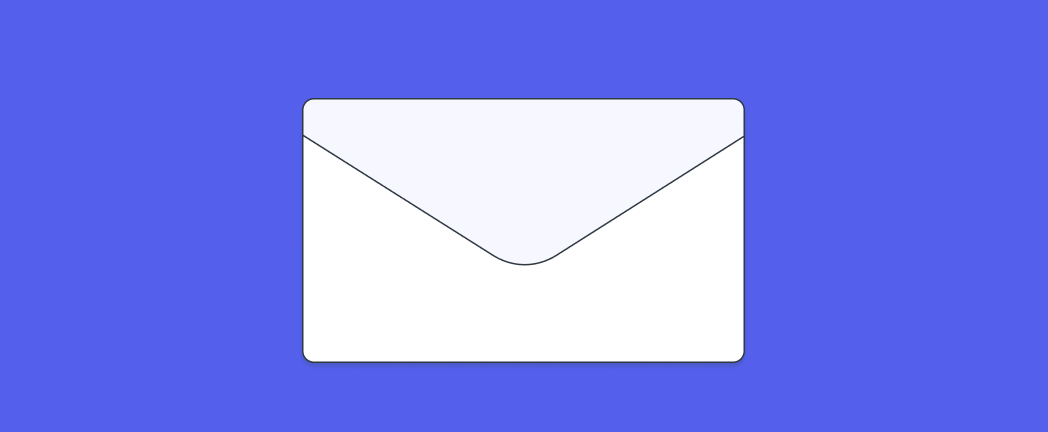
I'm regularly asked by candidates whether they should write a cover letter, and what to include. I'm noting down a few recommendations that I believe will help you stand out.
When to write a cover letter?
If you are excited about the role, I believe there's only one situation where you shouldn't write a cover letter.
When applying for a job, sometimes companies ask for additional answers alongside a CV (e.g. "What excites you about our company?"). In this case I don't believe you need to write a cover letter. They've been helpful to give you a clear opportunity to stand out.
Otherwise, I recommend writing a cover letter. I say this because I advocate for making fewer, better applications. I know it's hard to spend more time on an individual application, especially when job searching feels like a numbers game. But I feel writing quality applications is a better strategy for securing a great role. If others are sending their CV and nothing else, and you're writing a well-crafted cover letter, you are more likely to stand out!
What to write in a cover letter
To structure the cover letter, imagine you're being asked these two questions and use one paragraph to answer each. Your cover letter should be brief (1 page).
1 - What excites you about company X?
The best way to stand out is to demonstrate you have put time and thought into understanding the company.
There are simple things you can do that will instantly elevate you above candidates who haven't put additional effort in:
- Refer to an article/blog which talks about the company
- Talk about how you've tried the product and what you like
- Write why you like the mission, or show an understanding of the problem being solved
I've also written an article on 6 areas to research before interviewing at a startup - these are all useful areas to include in a cover letter to show you're excited.
Once you've written this paragraph, ask yourself "If I replaced company X with another company, for example a competitor, would it still make sense?". If the answer is yes, you probably need to add more insight and detail. The aim is to avoid seeming generic.
I often see receive cover letters with sentences like "I want to join Otta as you are changing recruiting" and this isn't enough insight to help you stand out. In fact, sometimes it can work against you, as you've made the effort to write a cover letter but haven't taken the time to write in-depth!
2 - Why do you want this role?
Your CV tells the hiring manager about your previous experience, but it doesn't say anything about your motivations. I believe a cover letter is a great opportunity to tell more of your story.
Here are some example questions that you may want to answer in this paragraph:
- What is it about this role that you really like? (Look carefully at the job description and the areas that excite you)
- If you're applying for a more senior role, why is now the right time?
- If you're moving from a corporate to a startup, why are you confident that a fast-growth environment is right for you? (I've written an article about the qualities startups look for when hiring )
- If you're making a career shift (e.g. strategy to marketing), what is your reasoning? What have you done to make yourself confident this is the right move for you?
- What do you want to achieve in your next role?
- Where do you want to be in 3-5 years and how will this role help you?
- What's important in your next role?
You don't need to tell your whole story (e.g. why you decided to start your career as a software engineer). Ideally you'll find a few interesting areas where the hiring manager will think "yes, that's exactly what we need!" and this will elevate you above other candidates.
Don't make your cover letter an extension of your CV
When reading cover letters, I make this comment about 50% of the time. A lot of candidates use a cover letter to write their CV in more detail. Either by writing more achievements, including deeper detail about projects, or repeating selling-points from the CV.
In my experience, a hiring manager will use the CV to judge your experience and suitability. They're looking to the cover letter to find something else to excite them. I believe my advice (explaining your excitement about the company and why you want the role) will help you stand out more.
If you find yourself using a cover letter to write more detail, I recommend going back to your CV and make edits to include those details in a concise way.
Ready to start your job search?
Find your next role at a fast-growing company
Writing a LinkedIn cover letter
LinkedIn is a popular professional social network that allows employers to post open positions and receive applications. In some cases, these applications require a cover letter submitted directly through the platform. While a LinkedIn cover letter is similar to a standard one, being on the platform allows you to leverage certain personalization features to impress recruiters and give you the best chance of landing the job you want.
How to make a cover letter on LinkedIn
When it comes to cover letter examples , LinkedIn doesn’t supply any. The platform has its own set of rules and expectations, and it's important that you follow them. Here are a few things you need to know about navigating the process and making sure your professionalism shines through.
Search for a job post
LinkedIn makes it easy for job hunters to search for roles they’d like to apply for. From your profile page, simply click on the “Jobs” icon at the top of the page. On the “Jobs” page, you’ll be able to see the top opportunities LinkedIn recommends based on the qualifications listed in your profile.
The site will also provide a plethora of other suggestions, including keywords to search, companies hiring for your skills, and jobs where you’re likely to be a top applicant.
Apply through the “Apply” or “Easy Apply” functions
When you choose a particular role, LinkedIn will show you a detailed job description, as well as the posting date, number of applicants, and current employees you may know. There will also be an option to either apply for the position or save the posting to come back to it later.
To apply for the position, click the “Apply” button. In some cases, this button will take you to the employer’s website to submit an application through their online system. If there’s an “Easy Apply” button, clicking it will usually take you to an on-platform application.
There, you’ll be asked to upload your resume as a file attachment, fill in your personal details, and possibly answer a few questions. There may also be a message box where you can type your cover letter.
Personalize your cover letter
Applying on LinkedIn provides added benefits for applicants. In many cases, you’ll have the unique ability to see who posted the job and what their role is. There’s often a button next to this feature that allows you to message that person to ask questions about the posting.
The bottom of the job description also usually includes a link to the company page. From there, you can sometimes see the profiles of employees in key roles.
You can also click the “People” tab on an employer’s LinkedIn page to search for the name of a hiring manager. This will help you personalize the cover letter templates you use so you can address them to the right person instead of simply including a generic greeting.
Highlight relevant skills and experience
Another benefit of using LinkedIn to apply is that employers can see the relevant skills and experience listed in your profile. Consequently, they’ll be able to cross-reference the skills you include in your cover letter and resume.
Though many resume articles may tell you that this information is sufficient for your letter, keep in mind that LinkedIn doesn’t always provide adequate space to discuss your skills in context. Your profile won’t be able to align those skills with the employer’s posted job description.
For that reason, it’s important to connect the dots for the employer in your LinkedIn cover letter, explaining how your background, skills, and experience have set you up for success and make you the best candidate for the position.
This tactic is crucial for differentiating yourself from other applicants on LinkedIn and is especially important for roles where the platform indicates that there are already many applicants.
Include a call to action
This is one way writing a LinkedIn cover letter aligns with the conventional wisdom found in many cover letter articles .
Make sure to end your cover letter with a clear prompt for the person reading it to take the next step in the hiring process. Reiterate your enthusiasm and invite them to view any materials or portfolios you’ve included on your profile or application.
Tell the hiring manager you’d love to set up an interview or a time to talk further about how you can help the company reach its goals. Let them know you’re available to chat through LinkedIn and provide another contact method in case they prefer an alternative venue.
Proofread and edit
LinkedIn makes writing a cover letter quite easy. That said, it’s important to remember that while social media platforms can seem casual, that doesn’t mean you should take your cover letter and application any less seriously.
To appear as professional as possible, make it a point to proofread and edit your LinkedIn cover letter and resume to confirm that they’re error-free. If you’ve used a cover letter or resume template , alter parts of it to reflect your unique skills and background.
Send your application
Once everything is complete, submit your job application on LinkedIn by clicking the appropriate button. You also have the option to save your application so you can finish and submit it later.
Remember that employers can’t see your application until it’s submitted. If you forget to take this step, you won’t be in the running for the position you’re interested in.
Expert Tip:
Consider using a typing assistant or online proofreading tool to help you edit your cover letter before you send it. That way, you can spot errors and make changes inside the LinkedIn message box as you type, so you won’t have to worry about coming across as unprofessional.
To-do’s after sending your application
You may wonder what happens next once your application package is in the employer’s hands. Unlike the company’s applicant tracking system (ATS) , which may or may not give updates about your application, you can track your applications on LinkedIn.
Simply navigate to the “Jobs” tab on your profile, click “My Jobs” on the left-hand side, and choose “Applications” to see the jobs you’ve applied for. You can also adjust your notification settings to receive job application updates via email or the LinkedIn app, including recruiter views or resume downloads.
If you want to continue your job hunt and submit another resume and cover letter , LinkedIn makes it easy. If requested or given room to do so, including a LinkedIn cover letter in each of those applications can go a long way toward helping you stand out amongst a sea of applicants.
Finally, if you haven’t heard back from the company within one to two weeks, consider sending a follow-up message via LinkedIn.
Remind the hiring manager or recruiter of your qualifications, highlight why you’re a great fit for the role, and let them know you’re enthusiastic about the possibility of an interview to discuss how you can be of value to the company.
“While social media platforms can seem casual, that doesn’t mean you should take your cover letter and application any less seriously.”
Use LinkedIn to your advantage in your search for the perfect role
As easy as it is to apply for a job on LinkedIn, it’s still important to ensure that your cover letter and application come across as poised and professional.
Before applying, familiarize yourself with the platform functions and use them to research the recruiter or hiring manager’s name. When you write your cover letter, personalize your greeting using that name instead of going with something more generic.
Additionally, give context to the experience and skills you’ve listed and explain why you’re a good fit for the role, using your LinkedIn profile as a resume example of sorts. Include a call to action at the end, and don’t forget to proofread your letter before sending it off.
If you’re coming up blank trying to compose your letter, consider using a LinkedIn cover letter example as your guide.
Reviewing cover letter and resume examples can help you determine the appropriate structure and maintain a professional tone throughout. With the right resources, you can draft a standout cover letter that gets your application moved to the top of the digital stack.
Get ahead of the competition
Make your job applications stand-out from other candidates.
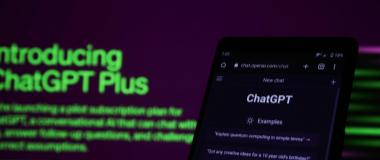
ChatGPT Cover Letters: Are They Worth It?

Achieving the Ideal Cover Letter Length

Including Salary Requirements in Cover Letters

How to Write a Cover Letter When You Have No Experience
A s a job seeker, a cover letter is your chance to make a great first impression. It can help you stand out and show your potential as a valuable addition to the team.
Writing a persuasive cover letter without prior work experience can be challenging. But with the right approach, you can make a compelling case for why you're the perfect fit for the job. In this article, we'll help you write an effective cover letter that leaves a lasting impression on your potential employer.
1. Begin With a Strong Opening Statement
Your opening statement should be attention-grabbing and highlight your interest in the position. Start with a brief introduction about yourself and why you're applying for the job. Avoid generic or cliché openings, such as "I am writing to apply for the job opening at your company."
Instead, try to show your personality and interest in the position. If you know someone at the company or have a connection, mention it in the opening statement. For example, "I'm excited to hear about this opportunity from a friend in your marketing department."
Your opening statement should be no more than two to three sentences long. Remember, the goal is to get your potential employer to keep reading and learn more about you.
2. Highlight Your Education and Relevant Coursework
When writing a cover letter, you may want to highlight your education and relevant coursework. Your education provides a strong foundation of knowledge and skills that can be applied to a job. While doing so, mention your degree and any relevant coursework you have completed.
For instance, if you're applying for a marketing role, showcase any relevant marketing coursework or projects. You can also highlight relevant accomplishments. It's important to note that not all achievements will be relevant to every job application.
If your academic achievements are relevant to the position, mention them in your cover letter. Provide specific examples of how they showcase your strengths and potential as a candidate.
3. Focus on Your Strengths and Transferable Skills
Transferable skills are skills that can be applied across different jobs and industries. While demonstrating transferable skills on your CV helps, including them in your cover letter can further enhance your job application.
Common transferable skills include teamwork, leadership, problem-solving, time management, and more. Instead of listing your transferable skills, give specific examples. Share experiences from any team activities where you tackled challenges and found solutions.
4. Mention the Company Values That Align With You
Organizations often emphasize cultural fit during the hiring process. By highlighting your alignment with the company values, you provide evidence of your potential cultural fit for the work environment and team dynamics.
Research the company and identify its important values that resonate with you. Start by visiting the company's official website. Look for sections like "About Us," "Mission and Values," or "Our Culture." You can also check the social media profiles, employee testimonials, or any press releases that highlight the company’s values.
Once you've identified the company values you want to highlight, provide specific examples to support them. Share anecdotes or experiences that showcase how you have lived out these values. For instance, if one of the company values is "collaboration," mention a successful team project where you collaborated.
5. Use Keywords From the Job Description
Many companies use Applicant Tracking Systems (ATS) to screen and filter resumes and cover letters. These systems often scan for specific keywords to identify qualified candidates. By adding the right keywords, you can increase the chances of your cover letter aligning with the employer's requirements.
Pay attention to the specific words and phrases in the job description and mirror them in your cover letter. For instance, if the description mentions "attention to detail" as a required skill, use similar wording to describe your attention to detail in previous projects or assignments.
While it's essential to add relevant keywords, avoid excessive repetition or keyword stuffing. Aim for a natural flow in your writing. Focus on showcasing your skills and experiences rather than forcefully inserting keywords without proper context.
6. Express Your Enthusiasm
Next, as you end your cover letter, show your enthusiasm for the role and the company. It will show your potential employer that you are passionate about the opportunity. Highlight specific aspects of the company or the position that excites you. Refer to the company’s recent projects, initiatives, or achievements that have caught your attention.
While it's important to express enthusiasm, remember to maintain a professional tone in your cover letter. Strike a balance between enthusiasm and professionalism to show your interest and suitability for the role. Use a positive tone throughout your cover letter. Avoid generic phrases and opt for more specific and vivid descriptions that showcase your interests.
7. Proofread Your Cover Letter
After completing your cover letter, take a break before proofreading. This break helps you approach the proofreading process with fresh eyes, making it easier to spot areas that need improvement. Consider using the best spelling and grammar-checking tools or seeking help from a trusted friend or colleague.
Here's an Example of a Cover Letter
Dear [Employer's Name],
I am writing to express my strong interest in the [Position] role at [Company Name]. I was thrilled to learn about this opportunity from my friend, [Friend's Name], who works in your marketing department. From my research and conversations, I have come to admire [Company Name]'s commitment to innovation and its positive impact on the industry.
As a recent graduate with a Bachelor's degree in [Your Field of Study] from [University Name], I have developed a solid foundation in [relevant coursework or major subjects]. Through my coursework, I have gained a deep understanding of [specific concepts or skills relevant to the position], which I believe will contribute to my success in the [Position] role at [Company Name].
At [University Name], I had the privilege of working on various projects that required strong teamwork, problem-solving, and effective communication skills. In my marketing research course, I led a team project where we conducted extensive market analysis. We developed a comprehensive marketing strategy that resulted in a 30% increase in customer engagement for a local business.
Thank you for considering my application. I have attached my resume for your review. I would welcome the opportunity to further discuss how my qualifications align with the goals and vision of [Company Name].
Once again, I appreciate your time and consideration. I look forward to the possibility of joining the exceptional team at [Company Name] and contributing to its continued success.
[Your Name]
Stand Out With a Compelling Cover Letter
With a well-crafted cover letter, you can convey your potential and convince employers to consider you for the position. Remember to tailor each cover letter to the specific job and company, highlighting the most relevant aspects of your background and showcasing your interest in the opportunity.
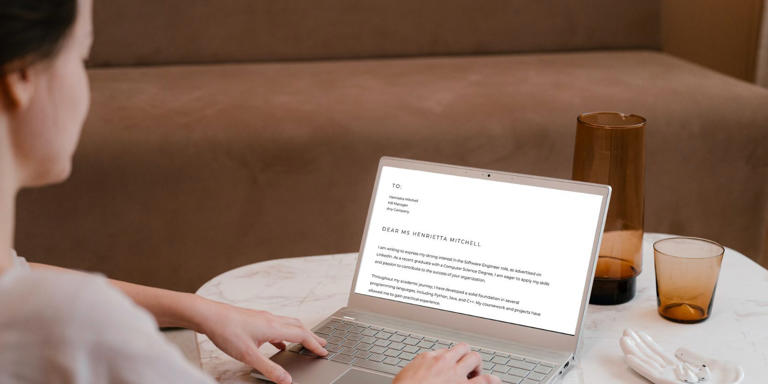
Our Recommendations
- Best Small Business Loans for 2024
- Businessloans.com Review
- Biz2Credit Review
- SBG Funding Review
- Rapid Finance Review
- 26 Great Business Ideas for Entrepreneurs
- Startup Costs: How Much Cash Will You Need?
- How to Get a Bank Loan for Your Small Business
- Articles of Incorporation: What New Business Owners Should Know
- How to Choose the Best Legal Structure for Your Business
Small Business Resources
- Business Ideas
- Business Plans
- Startup Basics
- Startup Funding
- Franchising
- Success Stories
- Entrepreneurs
- The Best Credit Card Processors of 2024
- Clover Credit Card Processing Review
- Merchant One Review
- Stax Review
- How to Conduct a Market Analysis for Your Business
- Local Marketing Strategies for Success
- Tips for Hiring a Marketing Company
- Benefits of CRM Systems
- 10 Employee Recruitment Strategies for Success
- Sales & Marketing
- Social Media
- Best Business Phone Systems of 2024
- The Best PEOs of 2024
- RingCentral Review
- Nextiva Review
- Ooma Review
- Guide to Developing a Training Program for New Employees
- How Does 401(k) Matching Work for Employers?
- Why You Need to Create a Fantastic Workplace Culture
- 16 Cool Job Perks That Keep Employees Happy
- 7 Project Management Styles
- Women in Business
- Personal Growth
- Best Accounting Software and Invoice Generators of 2024
- Best Payroll Services for 2024
- Best POS Systems for 2024
- Best CRM Software of 2024
- Best Call Centers and Answering Services for Busineses for 2024
- Salesforce vs. HubSpot: Which CRM Is Right for Your Business?
- Rippling vs Gusto: An In-Depth Comparison
- RingCentral vs. Ooma Comparison
- Choosing a Business Phone System: A Buyer’s Guide
- Equipment Leasing: A Guide for Business Owners
- HR Solutions
- Financial Solutions
- Marketing Solutions
- Security Solutions
- Retail Solutions
- SMB Solutions

Online only.

6 Things You Should Never Put in Your Cover Letter
Table of contents.
When submitting a job application, your resume can only go so far. Resumes tell prospective employers about your experience and education, but they’re essentially fact sheets. A cover letter gives applicants the opportunity to share more detailed information on why they’d be a good fit for a particular role at a specific company.
We’ll outline some common cover letter mistakes to avoid and share tips and best practices for cover letters that show you in the best possible light.
Cover letter mistakes to avoid
A cover letter can show a hiring manager why you’re the best fit for a position, so getting it right is worth your time and effort. However, crafting an effective cover letter can be challenging. You must showcase your skills without appearing self-important or succumbing to cliches.
Here are six cover letter mistakes to avoid at all costs.
1. Highlighting where you lack specific skills
It’s easy to feel vulnerable when applying for a job, especially if you have limited work experience or few required skills. However, starting a cover letter by underselling yourself or drawing attention to the skills or knowledge you lack is never advisable.
Author and career development professional Lavie Margolin says cover letters aren’t the place to list your weaknesses. “I have seen one too many cover letters with the following phrase: ‘Although I do not yet have,'” Margolin noted. “If you do not have something, why are you emphasizing it?”
Instead, Margolin says job seekers should focus on existing in-demand career skills , experiences and talents that will interest the potential employer.
“If you are looking for a job, then you are in the sales business. What you write in your cover letter should most effectively sell the skills, experience and abilities that you do have, as opposed to emphasizing those things that are lacking,” Margolin advised. “Emphasizing a weakness on your cover letter may be costing you the job.”
2. Not proofreading for typos and cliches
Sometimes, job seekers get so caught up in finding the best way to express their ideas that they forget to pay close attention to their cover letter’s details. Typos, using the wrong company information and cliches are common mistakes to look for in your proofreading efforts.
- Look for cover letter typos. According to Joe Weinlick, COO of Catalyst Experiential, cover letter typos are an egregious yet common mistake. Rigorously proofreading your cover letter will allow your content to shine. “Spell-check is your friend. Use it, but don’t rely on it,” Weinlick advised. “Print out your cover letter, read it from start to finish and make sure there aren’t any typos before sending it out. Your cover letter is the first impression you make on a hiring manager – make sure it’s a good one.”
- Ensure you use the correct company information. You may be tempted to reuse parts of your cover letter when applying for similar positions with different companies. However, failing to update the company information for each letter is an unforgivable offense. Double-check that you have the correct details for the company, including the specific position for which you are applying and the name of the hiring manager, if possible.
- Watch for cliches and buzzwords. When proofreading your cover letter, look for and eliminate cliches and overused buzzwords . Instead of using vague words to describe your work ethic or experience (“I’m a motivated self-starter”), provide specific examples that demonstrate the qualities you’d like to highlight. “Don’t use buzzwords,” warned Bob Kovalsky, vice president of Volt Workforce Solutions. “Including descriptors such as ‘detail-oriented,’ ‘hardworking,’ ‘team player’ and ‘proactive’ doesn’t tell HR managers anything about your experience.”
Watch for cliches and worthless words in your LinkedIn profile . Overused buzzwords won’t convey your unique qualifications and personality.
3. Remaining stuck in the past
Maybe you were let go from your last job, or maybe you’re looking for new opportunities. Regardless of the reason for your job search , don’t spend your cover letter’s limited space focusing on your past.
“The worst thing a potential employee can do [in a cover letter] is to explain why they left their current or former position,” shared Kim Kaupe, co-founder of Bright Ideas Only. “It’s like starting out a first date by talking about your ex! I don’t want to hear about your past; I want to hear about your now and future and how you are going to become an asset to my company.”
Steering clear of the past is especially important if you had a contentious relationship with an employer. “Saying that you’re looking for a new opportunity because your previous employer was unfair or you had an incompetent boss will only make you look bad,” warned Tracy Russell, a talent acquisition coordinator at Intuit. “Oftentimes, if this type of negative information is in the cover letter, recruiters won’t even look at the resume.”
4. Talking about money too soon
There’s a time and place to discuss salary during the hiring process , but your cover letter isn’t it. Lisa Benson, president and CEO of Mary Kraft HR, advises against providing any unsolicited salary information in the cover letter “unless [you] are specifically asked to do so, particularly if there is a disparity between what is advertised or indicated in the ad [you] are responding to. No prospective employer wants to hire someone who is only about the money.”
5. Making it all about you
Another common mistake applicants make is using their cover letter to boast about their talents without acknowledging how they will use them to benefit a prospective employer.
“The worst thing a candidate can do in their cover letter is make it all about themselves and what they’re looking for,” said Ian Yates, senior director of corporate accounts at Thermo Fisher Scientific. “The best thing to do is focus on why they’ll be a great fit, how they’ll make a contribution, and what they’ve done, or will do, to support [the organization].”
“It is a fine line between confident and arrogant,” added Sue Hardek, managing director at ZRG Partners. Hardek noted that candidates should avoid overselling themselves and being boastful about accomplishments and strengths.
Job candidates should also steer clear of oversharing personal history or exaggerating or lying on their resume or cover letter.
6. Letting AI do the heavy lifting
Many generative AI companies boast that their AI tools can save time by drafting perfect cover letters. While AI is transforming business , including the job search process, you must be especially careful when using it for your cover letter.
Opinions about using AI in the workplace are mixed. You don’t want to risk coming across a hiring manager who suspects an AI-generated cover letter and immediately tosses your application. Worse, AI might utilize copied text or provide other job seekers with the same phrasing, leading hiring managers to suspect you of plagiarism.
AI can be a good place to start, but you should never rely on it for a final product. AI can help you generate ideas, synthesize your experience with the history and needs of the company, or assist with general editing. But when it comes to the final product, you want your voice to shine through, so ensure the writing is your own – even if you’ve had some help.
What is a cover letter?
A cover letter is a company’s first introduction to who you are as a person. Your resume will explain your previous work experience and skills, but your cover letter is an opportunity to show recruiters your personal side. It’s also a chance to demonstrate why you stand out from the crowd. Employers get many applications, many of which display similar backgrounds and experience. A cover letter helps narrow down their talent pool.
Cover letters are typically written in a three-paragraph format and should be no more than 300 words.
The benefits of a cover letter
Some job listings require the candidate to submit a cover letter, while others make it optional. However, applicants should always take the time to write a cover letter to express their interest in the company and flesh out their professional experience.
A cover letter brings the following advantages:
1. Cover letters personalize your application.
Even great resumes don’t allow applicants to show off their writing skills. A cover letter can help candidates sell themselves by letting their personalities shine. Recruiters get a sense of who the candidate is beyond their work experience and education. Cover letters also allow candidates to discuss parts of their background that may not be explicitly stated on a resume but are relevant to the job they’re applying for.
2. Cover letters showcase your interest in the position and company.
Many candidates blindly shoot off job applications, believing in quantity over quality. To be as efficient as possible, they’ll either send a generic cover letter or fail to send one. However, this is a missed opportunity.
A cover letter with specific details about why you’d be a great fit for the company shows you’ve done your research and are interested in working for that organization. Employers will notice candidates who researched the business and its company culture . These candidates show they want to be there specifically – they don’t just want a job.
3. Cover letters demonstrate your hard work.
Taking the time to draft a well-researched cover letter shows employers you’re self-motivated and passionate about the position. The skills of researching, writing and submitting clean copy before the deadline demonstrate your ability to work and follow directions.
In addition to crafting an excellent cover letter, job candidates should prepare for the interview process and send a thank-you letter to follow up.
How to write a good cover letter
Hiring managers may receive hundreds of cover letters and resumes for a single job post. Potential employees have only a few seconds to make a good first impression, and a boring cover letter could land them straight in the “no” pile.
Follow these eight tips from hiring experts to write a cover letter that will land you an interview:
1. Be yourself in your cover letter.
You don’t want to sound like everyone else. Give hiring managers a sense of your personality traits and how you might fit into the company.
“One key thing we look for is whether they’ve incorporated aspects of their personality into examples of how they would succeed in this position,” shared Margaret Freel, digital marketing specialist at No Dirty Earth and a former corporate recruiter.
Mentioning experiences that qualify you for a particular position is one way to personalize your letter. “Candidates should be concise and self-aware enough to know how their track record of results makes them unique and [be] able to relate that back to the position,” Freel advised.
2. Do your research and customize your cover letter.
Like your resume, your cover letter should be tailored to each position and company. Instead of a template-style cover letter, use industry-specific language referencing points from the job description and company website.
In your research, determine the hiring manager’s name, if possible. Addressing the hiring manager sets you apart. If you’re unsure who the hiring manager is, use a generic salutation – but only as a last resort.
“Address the cover letter to a specific person within the company, not the general – and much-hated – ‘dear sir or madam,'” advised Alina Cincan, managing director and co-founder of Inbox Translation. “This shows the candidate has done some research and is truly interested in working with that company, not just any company.”
Christa Shapiro, a director at the staffing firm Yoh, said one thing that always draws attention to a cover letter is mentioning why you want to be a part of a particular organization. Show a passion for the organization and industry. Employers don’t want to hire someone who won’t care about their work.
Getting a feel for the company will also prepare you for the types of interview questions the hiring manager will likely ask.
3. Be creative in your cover letter.
Hiring managers won’t finish reading your cover letter if they’re bored after the first line. A strong intro should find a unique way to highlight experiences or something specific from the job posting.
Grabbing their attention is key; hiring managers review tons of cover letters for each position. Find a creative way to stand out so the hiring manager notices you and moves on to your resume.
A creative cover letter moves beyond stiff cover letter templates and stock phrases. A great way to make your cover letter pop is to include a brief story that connects you to the company through its mission or product. “This exercise will undoubtedly separate you from the majority of other candidates,” advised Kenneth Johnson, founder and president of East Coast Executives.
4. Mention referrals in your cover letter.
If you were introduced or connected to a hiring manager via an employee referral or mutual industry contact, include that person’s name in your cover letter (with their permission).
“Candidates can include referrals in a cover letter to make them stand out,” said Bill Peppler, COO of staffing firm Kavaliro. “They should always gain permission for this before they name-drop, but the cover letter gives a great opportunity to include the name of someone that can vouch for your skills.”
5. Address potential resume concerns in your cover letter.
A well-crafted cover letter does more than explain why you’re the right person for the job. It also gives you a chance to explain items on your resume that might otherwise be considered red flags.
“Address any issues that may give a hiring manager pause, such as gaps in employment,” advised Diane Domeyer Kock, senior vice president and managing director at Robert Half.
Unfortunately, studies have shown that an unemployment bias exists, as some companies are reluctant to hire out-of-work people. However, the cover letter allows you to reclaim the narrative and demonstrate that you are an ideal candidate despite your employment history.
6. Don’t just repeat your resume in your cover letter.
While your cover letter should reference material from your resume, it shouldn’t simply be a word-for-word repeat. According to Jane Trnka, a career coach with Rady School of Management at UC San Diego, job candidates can use their cover letter to expand where necessary and discuss their listed experiences from a different angle.
“Craft the letter to acknowledge the requirements of the role and culture of the organization while highlighting the skills and experiences that align with the job description,” Trnka advised.
A cover letter is a great place to discuss any volunteer work or side projects that may not be on your resume but are relevant to the job you’re applying for.
7. Proofread and fact-check your resume.
As mentioned earlier, it’s imperative to check and double-check your cover letter for any grammatical or factual errors. Even the smallest mistake can make a bad impression on the person reading your letter.
“If there are errors of any kind, it’s a huge red flag,” warned Guryan Tighe, leadership coach and founder of Fourage. “This is your one opportunity to impress [the hiring manager] and show who you are. If there are typos, misspellings or formatting issues, it’s generally an automatic out.”
8. Keep your cover letter brief.
Hiring managers are busy and usually have many applications to review. Keeping your cover letter concise and to the point will improve the chances of it being read. It also makes the hiring manager’s job easier – which is always a good thing.
“The best cover letters can [be] concise, friendly and transparent,” explained Chris Wood, managing partner of Paige Technologies. “The best cover letters get right to the heart of why we are a great fit for them and why they are the best fit for us.”
Get your foot in the door
Perfecting your cover letter is an essential step in the job search process. You must spend time researching the company and crafting a creative, personalized letter that shows hiring managers you’ll be a valuable addition. Your cover letter should be unique to you and unique to each company you apply for.
But a great cover letter only gets your foot in the door. If you want to secure the job, you must carefully prepare for each part of the job search process. Whether it’s the cover letter or the interview, each step is a chance to show why you and the company you want to work for are a perfect fit.
Tom Anziano and Sean Peek contributed to this article. Source interviews were conducted for a previous version of this article.

Building Better Businesses
Insights on business strategy and culture, right to your inbox. Part of the business.com network.

IMAGES
VIDEO
COMMENTS
3. Show your personality. One of the most effective ways to make your cover letter stand out is to allow some of your personality to show through your writing. You can highlight your personality through your tone, vocabulary and any personal traits you choose to share. If you're an outgoing, confident and enthusiastic person, your cover ...
Step 3: Address your cover letter to the hiring manager—preferably by name. The most traditional way to address a cover letter is to use the person's first and last name, including "Mr." or "Ms." (for example, "Dear Ms. Jane Smith" or just "Dear Ms. Smith").
The most effective cover letters tell a story about why you are qualified for the role. Familiarize yourself with the job description. Explain how your experience qualifies you for the ...
First tip on how to write a cover letter. Use fewer words to say more. Tailor your cover letter to a specific job. Be proud of your past accomplishments. Address the hiring manager personally. Use keywords from the job description. Throw in numbers and examples. More 'don'ts' when writing a cover letter. Last cover letter tip: Proofread ...
Most recruiters like this type of cover letter because it is so to the point. This should consist of a one-page letter with plenty of white space - white space makes the content stand out - focusing on what you think is most important to the employer. The three parts are: 1. Short opening paragraph: Begin your cover letter with a strong ...
You might want to begin and conclude your letter with a "Thank you for your time" or "I appreciate this opportunity." Placing it at the outset is particularly beneficial in case the hiring manager's attention spans aren't conducive to reading the entire letter. Yes, it's a reality, but don't take offense - attribute it to the attention span ...
Step 1: How to Address a Cover Letter. When addressing your cover letter, it's essential to find out the name and title of the hiring manager or recruiter whenever possible. Addressing the letter to a specific individual adds a personal touch and demonstrates your initiative. A quick note on how to address a cover letter without a name.
Take a look at this article on how to write a standout cover letter and get started creating your own letter today! The importance of a cover letter. When looking for jobs, first impressions matter. And sure enough, a professional resume builder can help you create a resume that leaves a lasting impression. But a compelling and well-crafted ...
At the top of your cover letter, include your name, address, phone number, and email address. Then, include the date of writing the letter, followed by the recipient's contact information, such as the hiring manager's name, job title, and the company's address. 2.2 Salutation. Address the cover letter to the hiring manager whenever possible.
Avoid addressing the recipient with "Dear Sir or Madam," which is outdated and impersonal. It's always best to address them by their title and name. For example: Good cover letter greeting examples: "Dear hiring manager,". "Dear [XYZ Company] team,". "Dear Customer Acquisition Hiring Manager,". Weak cover letter greeting examples:
Step 1: Verbalize the Pain. Use the cover letter to show the reader that you understand the company's challenges, struggles, etc., and how you are the perfect candidate to solve these issues. In other words, show them that you understand the pain and can make it better. Pain takes many shapes and forms, from seamless project execution in ...
Respectfully, Kind regards, Best regards, Yours truly, Then, make two spaces below the salutation, and type your full name. For some professional (but optional) flair, sign your cover letter either with a scan of your signature or by using software like DocuSign. 8. Check your cover letter's content and formatting.
E. Exemplify your strengths. Avoid, at all costs, describing yourself as a "team player" or a "people-person.". It's like a graphic designer using the font Comic Sans—it's overused, oversimplified, and it underplays your unique attributes. Instead, show off your skills with descriptive statements like "I'm an expert ...
Sign off professionally. Finish your cover letter with a friendly term such as, "kind regards" followed by your name. Then add a professional signature to the bottom, like the one below; This makes the cover letter look professional and ensures that recruiters have; Your full name. Phone number. Email address.
The Cover Letter That Explains 'Why,' Not Just 'How'. The 'We're Meant for Each Other' Cover Letter. The Cover Letter with H.E.A.R.T. Short-and-Sweet Cover Letter Example. The Short Story. The Bare Bones Cover Letter. The Breezy Follow-Up. The Administrative Assistant Cover Letter. The Internship Cover Letter.
Here's one to interview!". For this to happen, there are two things you want to be sure to do with your cover letter: (1) tell the hiring manager why you want the job, and (2) present a case for why you're the best candidate for the position. These are usually achieved through four components: a brief introduction, two meaty paragraphs ...
Starting off a cover letter with "To Whom It May Concern", "Dear Sir", or "Dear Hiring Manager" will only show that you didn't take the time to research the company. You will also need to include the hiring manager's information at the top, including: Hiring manager's name. Company name and address. Company phone number.
The introduction of your cover letter is your chance to grab the hiring manager's attention and make a strong first impression. You should start your letter by stating the position you're applying for and where you found the job posting. If someone referred you to the position, be sure to mention their name.
Just don't put, 'This is my first attempt at writing fiction,' and leave it at that. It doesn't inspire confidence. TONE. A cover letter should be professional, like the cover letter you would send with a job application, but you also want it to have some personality.
Here are five ideas to get a hiring manager's attention from the first line of your cover letter . 1. Show Excitement. When I interview candidates, the people that stand out the most are the people that smile genuinely, have an engaging attitude, and seem excited to interview. This holds the same truth for cover letters.
In a ferocious job market, a well-written letter can help you stand out from other applicants. It can showcase your skills, experiences, and enthusiasm for the role. However, many job seekers need help writing their cover letter. A good cover letter needs to showcase qualifications effectively and make a strong impression.
A lot of cover letters open with a generic introduction, so it is important to make your opening paragraph stand out. If the opening paragraph is boring and unimpressive, it will be nearly impossible for a recruiter to read your cover letter. ... When writing a cover letter for a social worker job, the best way to make a first impression is by ...
Be the first to add your personal experience. 6. Proofread Thoroughly. Be the first to add your personal experience. 7. Here's what else to consider. Be the first to add your personal experience ...
What to write in a cover letter. To structure the cover letter, imagine you're being asked these two questions and use one paragraph to answer each. Your cover letter should be brief (1 page). 1 - What excites you about company X? The best way to stand out is to demonstrate you have put time and thought into understanding the company.
Include a call to action. This is one way writing a LinkedIn cover letter aligns with the conventional wisdom found in many cover letter articles. Make sure to end your cover letter with a clear prompt for the person reading it to take the next step in the hiring process. Reiterate your enthusiasm and invite them to view any materials or ...
Cover Letter Guides Guides, tips, and advice for writing a convincing cover letter that makes you stand out from the crowd. Job Search Advice Tips and hacks for saving time and getting better results in your job search. LinkedIn Guides Learn how to craft the perfect LinkedIn profile. Guides on headlines, summaries, work experience, and more.
Tips For Writing A Career Change Cover Letter. 1. Personalize Your Approach: Address the letter to a specific person whenever possible.Doing so demonstrates attention to detail and a genuine ...
Instead, try to show your personality and interest in the position. If you know someone at the company or have a connection, mention it in the opening statement. For example, "I'm excited to hear ...
3. Remaining stuck in the past. Maybe you were let go from your last job, or maybe you're looking for new opportunities. Regardless of the reason for your job search, don't spend your cover ...